Another day; another ear worm! 🙂
Had a bit of a later start today and didn’t head out until about 0900… it was nice to get going when the sun was up! We had a big day planned to check out the Fez Medina. But first, we took a couple of pit stops. The first being to the Dar al-Makhzen or the Palais Royal, which is one of the many royal palaces belonging to the Alaouite sultan – ie: the current King of Morocco. The palace grounds seem enormous, it sits on some 80 hectares of land and no one really knows what it looks like as it is not open to the public. Mustafa (our local Fez guru) told us that the King of Morocco has an inordinate amount of power… he is the supreme head of the church in Morocco, he is also the commander in chief of Morocco’s military, he is effectively the head of an executive branch of the government, he can veto bills in parliament, hell, he can even dissolve parliament! Basically whatever he says goes… and he owns a bunch of palaces across the country – most of which rarely see him. This palace in Fez has seen him in residence for barely a month in the last two years. The royal palace is a popular tourist stop for its enormous ornate bronze doors in gates heavily decorated with zellige tilework and carved cedarwood. The innumerable hours of hand-craftsmanship that goes into making these things is simply phenomenal.
The royal palace is a popular tourist stop for its enormous ornate bronze doors in gates heavily decorated with zellige tilework and carved cedarwood. The innumerable hours of hand-craftsmanship that goes into making these things is simply phenomenal.



 Zellige is mosaic tilework technique that is achieved by taking individually chiselled geometric tiles and then setting them into a plaster base (for certain purposes, like small fountains, they use fibreglass to set them into place. It’s a really popular and prevalent form of Islamic art that we’ve seen replicated on a lot of Moroccan architecture. The geometric patterns are really appealing and you see them on walls, ceilings, fountains, floors, pools and tables.
Zellige is mosaic tilework technique that is achieved by taking individually chiselled geometric tiles and then setting them into a plaster base (for certain purposes, like small fountains, they use fibreglass to set them into place. It’s a really popular and prevalent form of Islamic art that we’ve seen replicated on a lot of Moroccan architecture. The geometric patterns are really appealing and you see them on walls, ceilings, fountains, floors, pools and tables. 
 Off to the left of this main gate is a small ‘servants entrance’… frankly, they probably deserve to use the main entrance seeing they come and go way more than the King!
Off to the left of this main gate is a small ‘servants entrance’… frankly, they probably deserve to use the main entrance seeing they come and go way more than the King!
The palace is set right in the middle of the 13th mellah – or Jewish Quarter. The area is a walled Jewish settlement which people often mistakenly compare to the European Jewish ghettos. The Jewish community was first confined to the mellah in the beginning of the 15thC and again in the early 19thC, but generally the Jewish community seems to prefer to be centrally located near their synagogues, so it’s a more ‘self imposed’ autonomous confinement nowadays. The Jewish quarter is typified by a very European feel to the architecture with these cedar balconies overhanging the streets. 

As we were walking through the Jewish Quarter, Mustafa pointed out some Moroccan black soap also known as beldi soap. Beldi soap is a high-alkaline soap made from olive oil and macerated olives to form a gel like goop. It’s a hideous green/black colour, and thankfully doesn’t smell anything like it looks! It does have an olive oil smell to it which isn’t unpleasant but certainly looks like something that might have come from a cow’s arse… they use it a lot in the hammams (traditional steam baths) in Morocco. Blerg!
 After a quick wander through the Jewish Quarter, we took a drive out to a lookout to have a look at the city of Fez. Fez is Morocco’s second largest city, behind Casablanca, with 1.4million peoples. It is largely locaed in a valley surrounded by the high grounds, and the old city or the Medina is divided by the River Fez which runs through the 9thC walled part of the city.
After a quick wander through the Jewish Quarter, we took a drive out to a lookout to have a look at the city of Fez. Fez is Morocco’s second largest city, behind Casablanca, with 1.4million peoples. It is largely locaed in a valley surrounded by the high grounds, and the old city or the Medina is divided by the River Fez which runs through the 9thC walled part of the city. These pictures show how closely packed the Fez Medina is – it is believed to be the largest pedestrian zone in the world. Not a single vehicle can enter the medina as it is a completely bamboozling labyrinth of winding alleyways some of which are barely 70cm wide. Donkeys, mules and horses are the only form of transport in the medina and everything is transported in via animal or hand cart.
These pictures show how closely packed the Fez Medina is – it is believed to be the largest pedestrian zone in the world. Not a single vehicle can enter the medina as it is a completely bamboozling labyrinth of winding alleyways some of which are barely 70cm wide. Donkeys, mules and horses are the only form of transport in the medina and everything is transported in via animal or hand cart. Walls of the Fez Medina…the holes in the walls are desinged to allow the high wind to pass through the walls rather than causing damage. Apparently the wind here gets so bad it can ‘knock over’ wall like this…
Walls of the Fez Medina…the holes in the walls are desinged to allow the high wind to pass through the walls rather than causing damage. Apparently the wind here gets so bad it can ‘knock over’ wall like this… Before we threw caution to the aforemented wind and ventured into the Medina, we took a stop at a local mosaic and ceramic factory. Pictoral mosaics like the one below are not particularly common. Usually you see the traditional geometric, typically Islamic styles of art still being replicated in mosaic work.
Before we threw caution to the aforemented wind and ventured into the Medina, we took a stop at a local mosaic and ceramic factory. Pictoral mosaics like the one below are not particularly common. Usually you see the traditional geometric, typically Islamic styles of art still being replicated in mosaic work.
 Piles of clay come straight from quarries and have zero purification or cleansing before being put to use.
Piles of clay come straight from quarries and have zero purification or cleansing before being put to use. 

 Turned bowls drying before their first firing.
Turned bowls drying before their first firing.
 The kilns used are still traditional kilns that have been used for hundreds of years… the ground up dark dirt seen in the front is actually ground up olive pits which are added to the kiln fires. Something to do with the oils being beneficial in the firing process, but I’ll admit the explanation was a bit disjointed.
The kilns used are still traditional kilns that have been used for hundreds of years… the ground up dark dirt seen in the front is actually ground up olive pits which are added to the kiln fires. Something to do with the oils being beneficial in the firing process, but I’ll admit the explanation was a bit disjointed.  Tile making in action – this guys spends all day making clay squares into more uniform, flat and tapered clay squares. :/
Tile making in action – this guys spends all day making clay squares into more uniform, flat and tapered clay squares. :/ 
 Painting the ceramics with glaze before the second firing.
Painting the ceramics with glaze before the second firing. Etching off the glaze before a second glaze is done.
Etching off the glaze before a second glaze is done. 
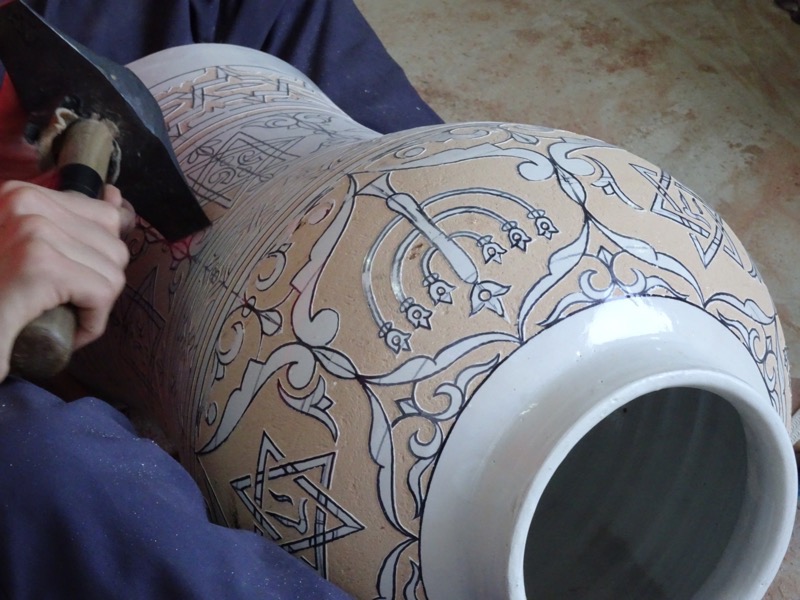

 Mosaic work is painstakingly done by hand. From the drawing of the designs onto the nice square tiles the previous guy was making…
Mosaic work is painstakingly done by hand. From the drawing of the designs onto the nice square tiles the previous guy was making…
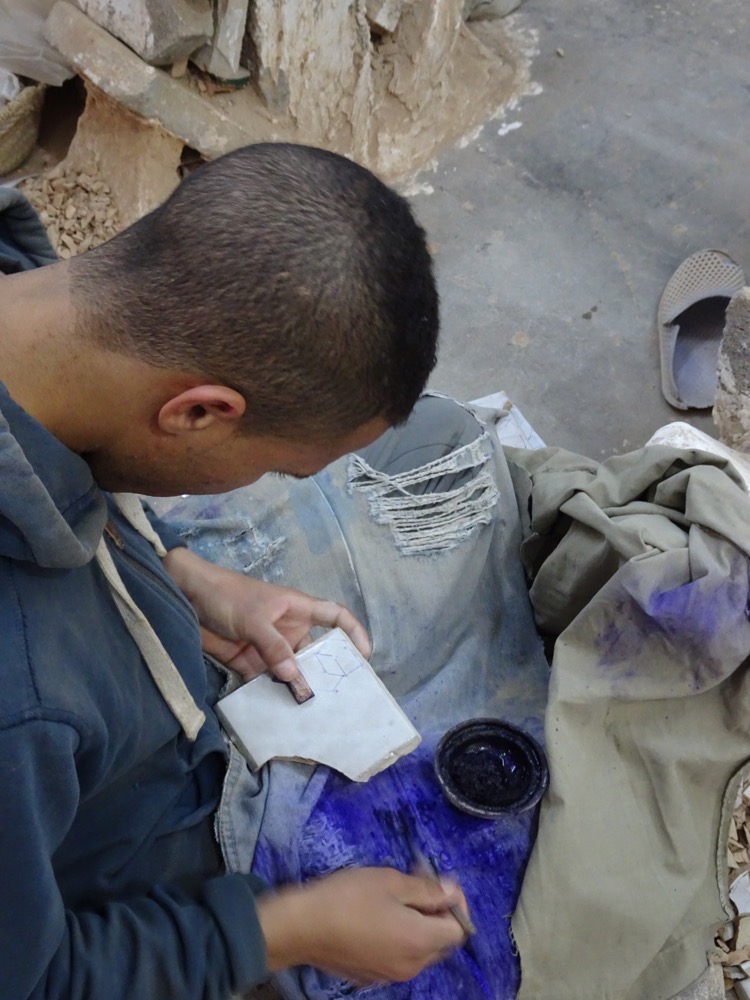 To the hand-chiselling to taper the pieces to the right shape so they may be fit together properly…
To the hand-chiselling to taper the pieces to the right shape so they may be fit together properly…
 To the laying out of the design – upside down so the plaster can be poured onto the back to hold it together!
To the laying out of the design – upside down so the plaster can be poured onto the back to hold it together! To the final chiselling of the finished product to clean up any irregular edges or overflowed plaster.
To the final chiselling of the finished product to clean up any irregular edges or overflowed plaster. The end results of this meticulous and time consuming work are amazingly beautful artworks.
The end results of this meticulous and time consuming work are amazingly beautful artworks.





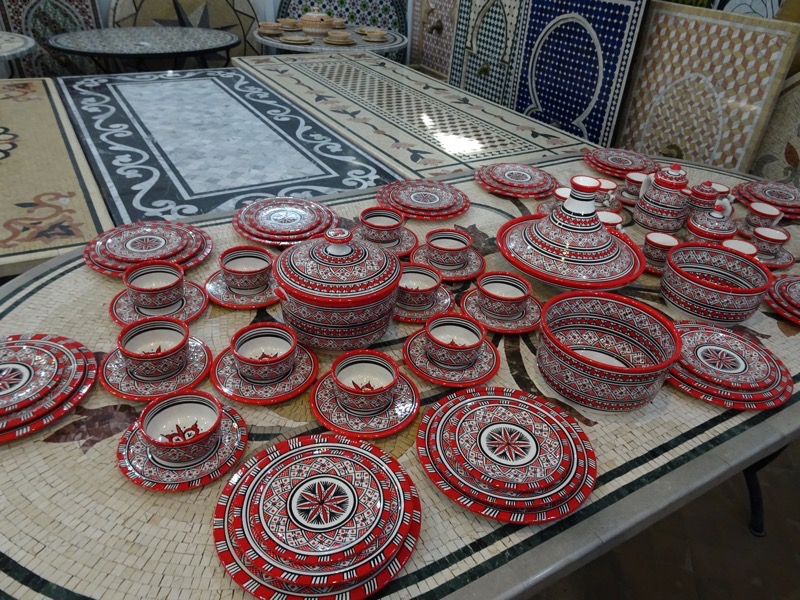




So many beautiful designs, so many gorgeous objects, so many overblown price stickers because this is tourist central!
After our brief foray into the exciting intricate and time consuming world of mass produced handmade ceramics and mosaics, we finally made our way into the world famous labryinthine Fez Medina! The World Heritage listed Fez al Bali Medina has alleys coming off alleys,stemming from alleys that are connected to even more alleys. Nearly all tourists who venture into this place come with a guide of some sort, becuase it is so easy to get completely lost and end up wandering around for kilometres to find your way out. We entered near a food section of covered markets.
The World Heritage listed Fez al Bali Medina has alleys coming off alleys,stemming from alleys that are connected to even more alleys. Nearly all tourists who venture into this place come with a guide of some sort, becuase it is so easy to get completely lost and end up wandering around for kilometres to find your way out. We entered near a food section of covered markets.  Dates, figs, seafood, meat, fresh fruits and vegetables, tea, grains, spices, herbs, and god knows what else was stashed into every available square inch of space in the covered shops. It is very similar to the Grand Bazaar in Isanbul.
Dates, figs, seafood, meat, fresh fruits and vegetables, tea, grains, spices, herbs, and god knows what else was stashed into every available square inch of space in the covered shops. It is very similar to the Grand Bazaar in Isanbul. 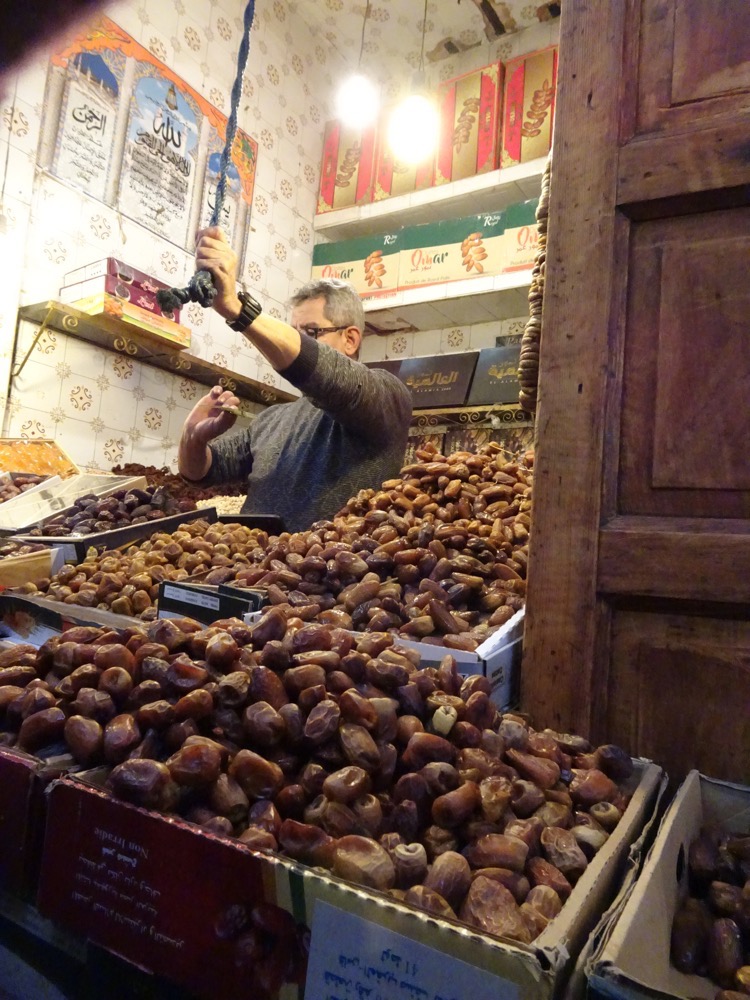 This man was selling live snails, and when he saw the tourists photographing his big tub of slimy delicacies, he started asking for money from people who shoved their cameras right over the tub of writhing creatures… tourists in the medina taking lots of photos and buying no produce must drive them crazy.
This man was selling live snails, and when he saw the tourists photographing his big tub of slimy delicacies, he started asking for money from people who shoved their cameras right over the tub of writhing creatures… tourists in the medina taking lots of photos and buying no produce must drive them crazy.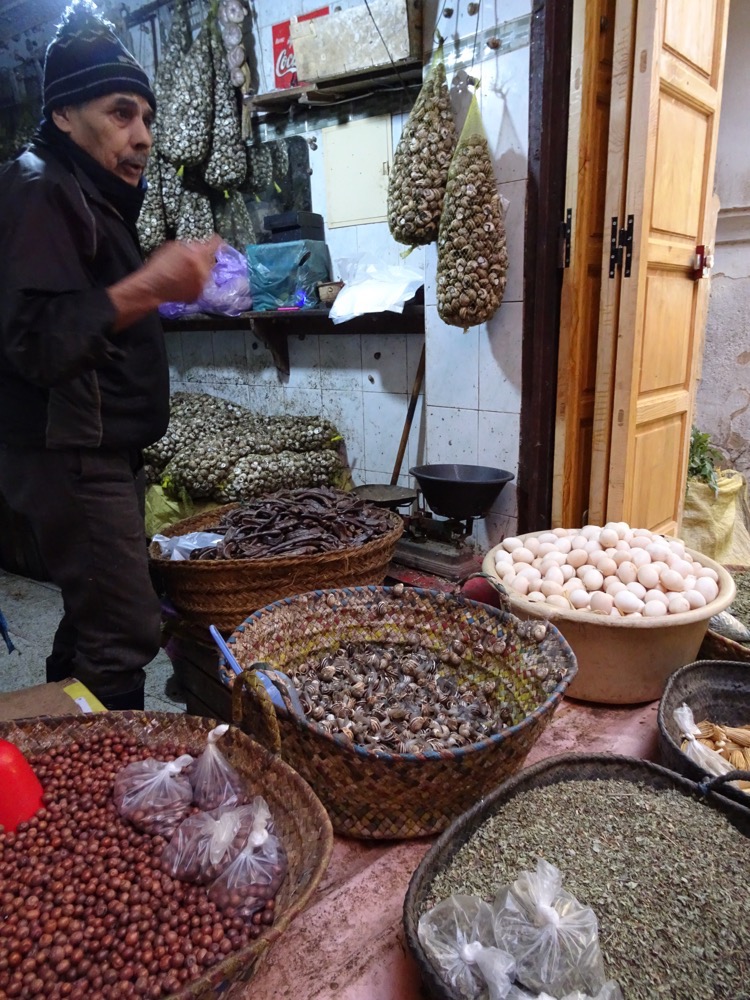 The camel heads hanging at the butcher’s shop is apparently the easiest way to tell people that you have camel meat in stock today. Little gory, definitely effective advertising.
The camel heads hanging at the butcher’s shop is apparently the easiest way to tell people that you have camel meat in stock today. Little gory, definitely effective advertising. 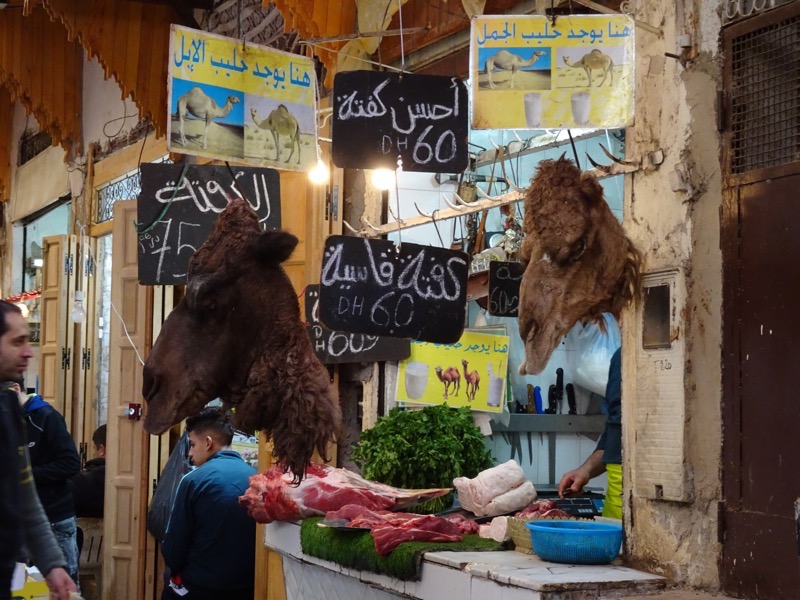 Seafoods – the large lumps of white flesh in the front of the table is some sort of local shark meat.
Seafoods – the large lumps of white flesh in the front of the table is some sort of local shark meat. Not far from the fresh produce and food stuffs are was dyers lane. I could see all this silk hanging up and it piqued my interest immediately. Apparently this is ‘saba silk’, which allegedly comes from the agave cactus plant – yes, that agave plant. Disappointinly, from what I’ve read up on this thread though, the bulk of the ‘saba silk’ used in Morrocan crafts is actually rayon that has been manufactured in Spain or India and comes in bulk and is dyed here for local use. I don’t think people care that their item has rayon embroidery on it – but generally speaking I don’t think it’s ethical to lead people to think that their item is made from hand harvested agave and spun by local women into something beautiful, when it’s actually brough in pre-manufactured from India. This is one of those things you hear about and think: ‘yeah, not entirely surprised’.
Not far from the fresh produce and food stuffs are was dyers lane. I could see all this silk hanging up and it piqued my interest immediately. Apparently this is ‘saba silk’, which allegedly comes from the agave cactus plant – yes, that agave plant. Disappointinly, from what I’ve read up on this thread though, the bulk of the ‘saba silk’ used in Morrocan crafts is actually rayon that has been manufactured in Spain or India and comes in bulk and is dyed here for local use. I don’t think people care that their item has rayon embroidery on it – but generally speaking I don’t think it’s ethical to lead people to think that their item is made from hand harvested agave and spun by local women into something beautiful, when it’s actually brough in pre-manufactured from India. This is one of those things you hear about and think: ‘yeah, not entirely surprised’.  Just outside the dyer’s lane was a small bridge that gave a view of the Fez River which runs thorugh the medina. It’s difficult to see in this photo with such a high contrast ration, but I can tell you unequivocally that the fish and eel and other seafood stuffs being sold inside, does NOT come from this river.
Just outside the dyer’s lane was a small bridge that gave a view of the Fez River which runs thorugh the medina. It’s difficult to see in this photo with such a high contrast ration, but I can tell you unequivocally that the fish and eel and other seafood stuffs being sold inside, does NOT come from this river.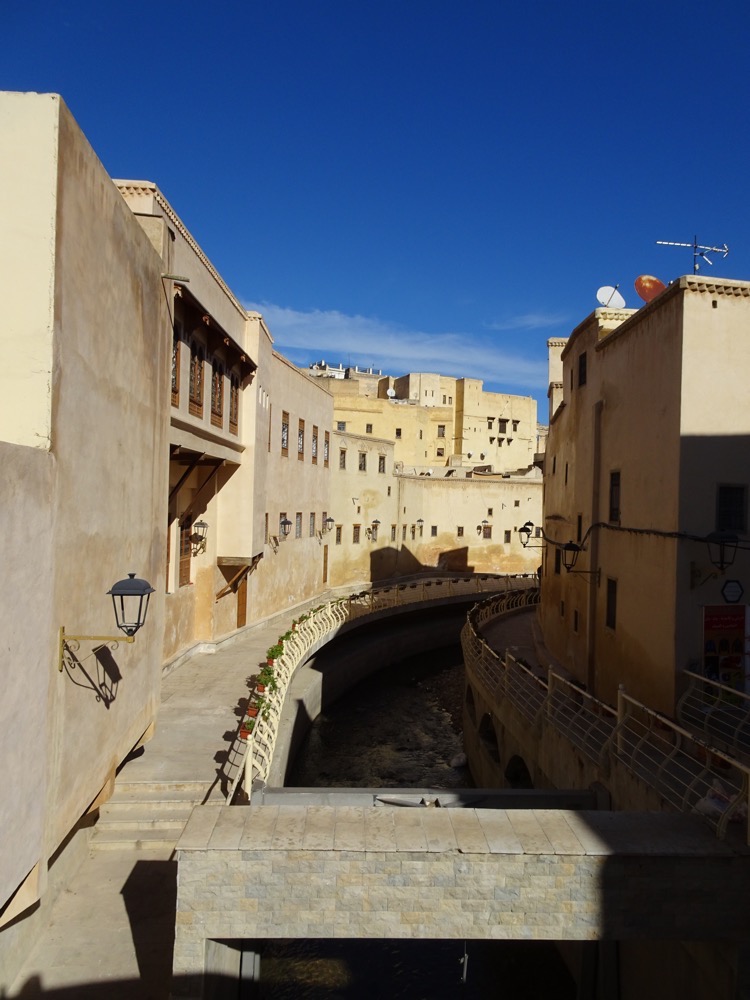 We saw loads of these large cone shaped items around the place and had to ask Mustafa what they were – they are food coverings, and apparently these huge velvet and embroidered ones are used for covering bread… ’tis a far cry from the Brabante bread bin that adorns my kitchen!
We saw loads of these large cone shaped items around the place and had to ask Mustafa what they were – they are food coverings, and apparently these huge velvet and embroidered ones are used for covering bread… ’tis a far cry from the Brabante bread bin that adorns my kitchen!

All over the medina were people selling brass objects, ‘silver’, copper and other items of metalware… a lot of these metal items were elaborately decorated with Islamic motifs. I did walk past a guy who was hand chasing and engraving these intricate designs into a place. Unbelievable – these large plates in particular, are one of those things I’ve seen around over the years, and I’ve always just assumed they were punched out by a large steel press somewhere…? Apparently – no. They’re largely handmade! 





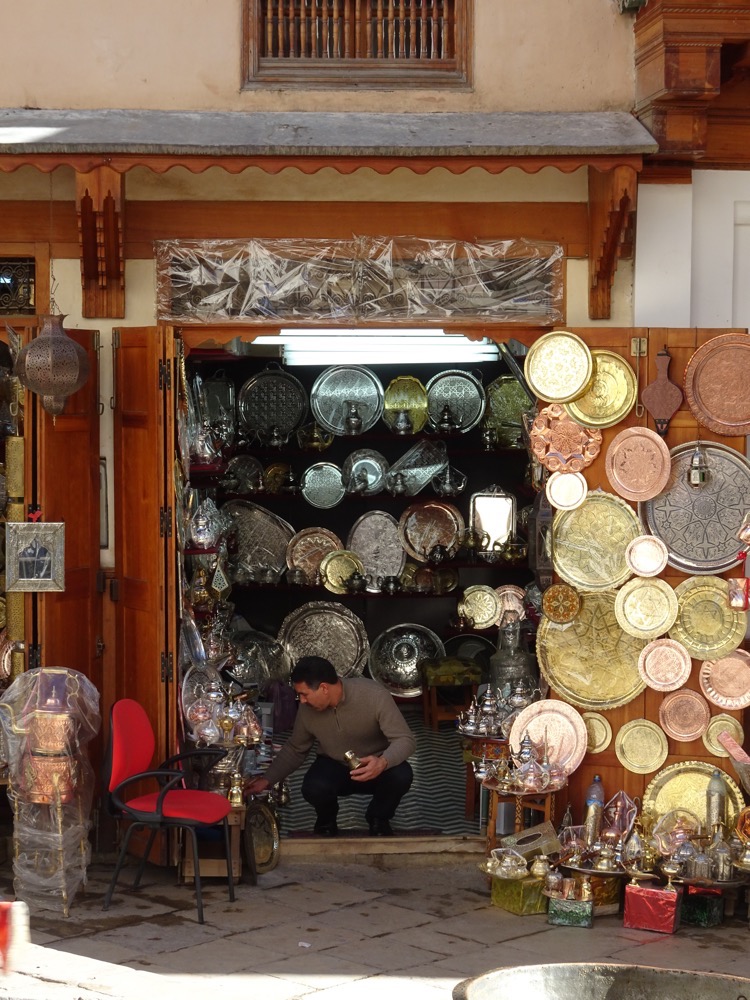
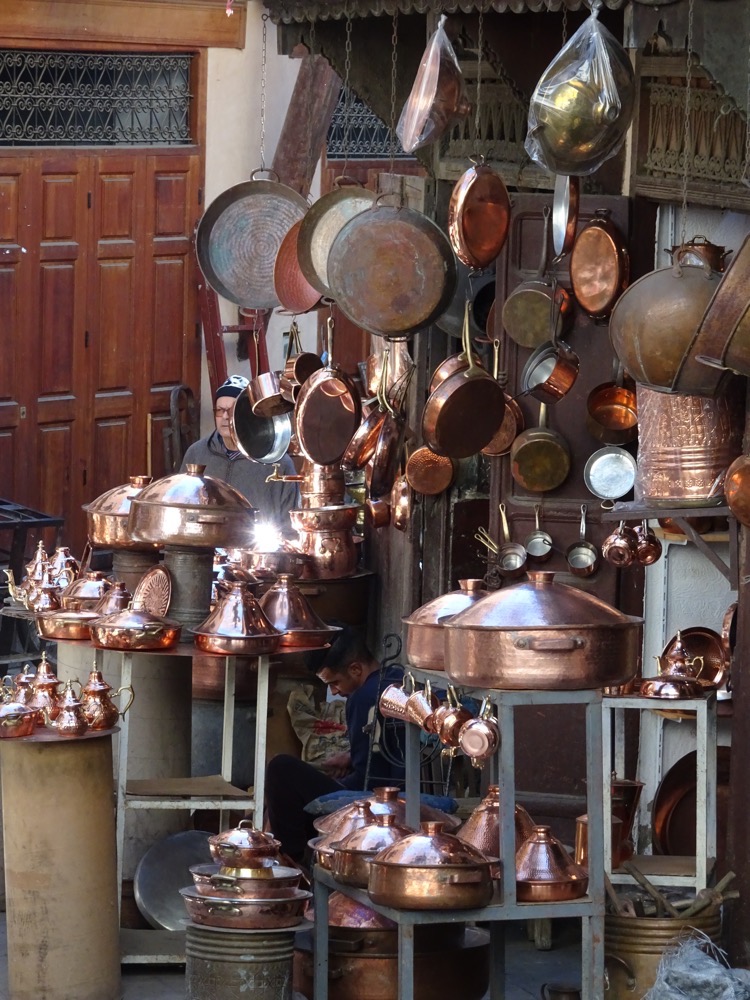 I managed to see another man doing some metal work on one of these metal topped tables, and was just amazed at how detailed they were.
I managed to see another man doing some metal work on one of these metal topped tables, and was just amazed at how detailed they were. Further into the the medina we found ourselves moving into the leather area. Morocco is famous for its leather industry, and the medina has three tanneries contained within its walls.
Further into the the medina we found ourselves moving into the leather area. Morocco is famous for its leather industry, and the medina has three tanneries contained within its walls.
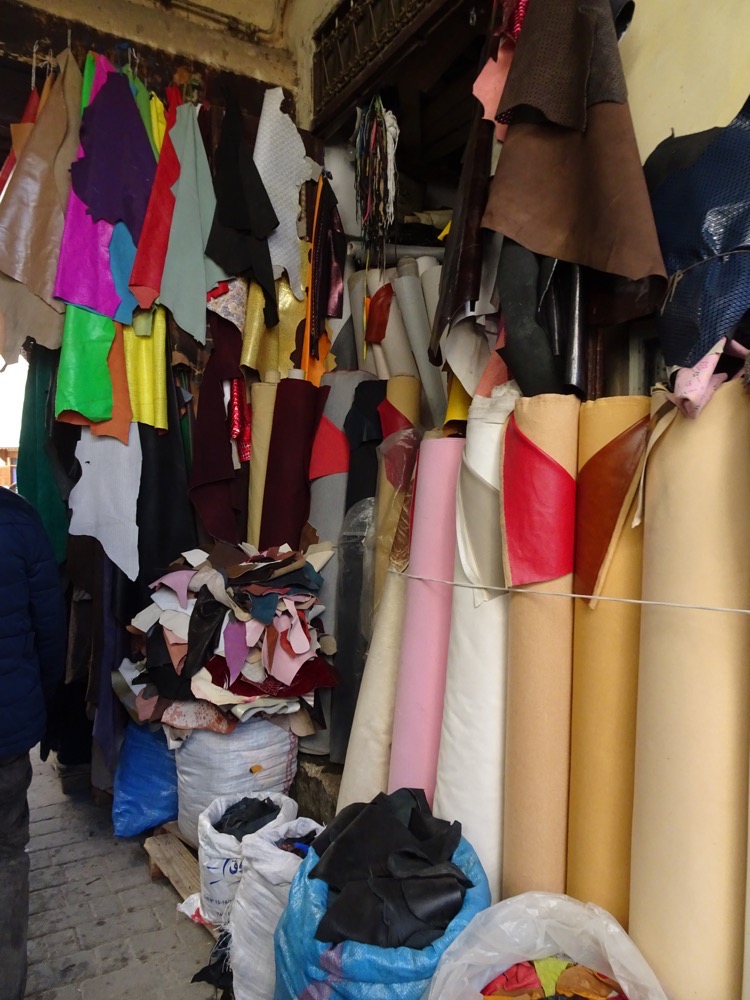
We did get a chance to visit the Chouara Tannery which, oddly enough, is located in the leather area of the medina. It was built in the 11thC and is the largest tannery in the city. Ever since its introduction to Fez, the tanning industry has been continually operating in the same place and in the same fashion as it did in the early centuries – that means there has been untold generations of people stomping around in the disgusting and fetid conditions of the tanning pits.
We walked into the tannery via a shop, and were (thankfully!) handed a very helpful sprig of mint… so that we could crush it up and smell it. The tannery absolutely reeks as a result of the processes and materials use to tan the leather.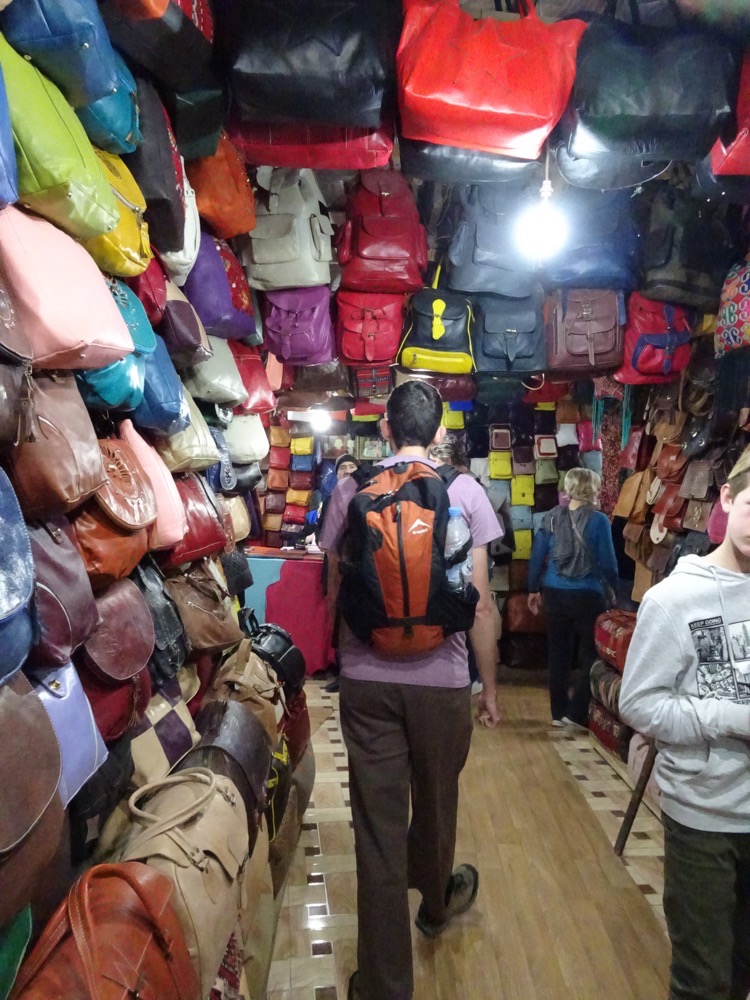 From a balcony overlooking the tannery, you can see numerous stone pits filled with different coloured dyes and liquids. Hides of cows, sheep, goats, and camels are processed here – the first step is to soak them in a series of white liquids – this first stage of the process uses a liquid that is a varying mixture of cow urine, pigeon shit, quicklime, salt, and water. This cleans the often very tough skins, and it normally takes about two or three days. After the cleaning and scraping, they are soaked in various dyeing solutions. The tannery uses many natural colourants such as poppy for red, indigo for blue, and henna for orange – same as they have used since the 11thC. After the skins are dyed, they get spread out on rooftops for sun drying. The leather then gets sold to various craftsmen who use it to make Morocco’s famous leather goods: bags, coats, shoes, and slippers. The entire leather production process in Morocco is done completely by manual labour and uses no modern machinery. They have retained methods that are unchanged since the medieval period… which is just amazing but also completely nuts.
From a balcony overlooking the tannery, you can see numerous stone pits filled with different coloured dyes and liquids. Hides of cows, sheep, goats, and camels are processed here – the first step is to soak them in a series of white liquids – this first stage of the process uses a liquid that is a varying mixture of cow urine, pigeon shit, quicklime, salt, and water. This cleans the often very tough skins, and it normally takes about two or three days. After the cleaning and scraping, they are soaked in various dyeing solutions. The tannery uses many natural colourants such as poppy for red, indigo for blue, and henna for orange – same as they have used since the 11thC. After the skins are dyed, they get spread out on rooftops for sun drying. The leather then gets sold to various craftsmen who use it to make Morocco’s famous leather goods: bags, coats, shoes, and slippers. The entire leather production process in Morocco is done completely by manual labour and uses no modern machinery. They have retained methods that are unchanged since the medieval period… which is just amazing but also completely nuts.
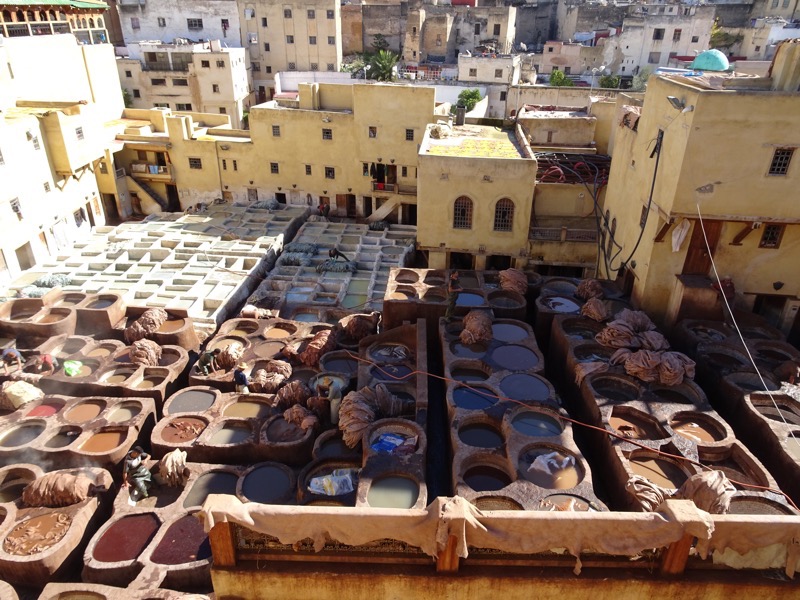
 Thank the gods for that spring of mint – the stench was enough to turn your stomcah. I can’t imagine how anyone survives a visit up here in the summer, and I really don’t know how anyone survives working down there their whole life!
Thank the gods for that spring of mint – the stench was enough to turn your stomcah. I can’t imagine how anyone survives a visit up here in the summer, and I really don’t know how anyone survives working down there their whole life!



 I love all these colourful ottomans… you buy them unstuffed and take them home and can stuf them with wadding, wool, rags, hair, whaterver you want. They’re not particularly small to transport though.
I love all these colourful ottomans… you buy them unstuffed and take them home and can stuf them with wadding, wool, rags, hair, whaterver you want. They’re not particularly small to transport though.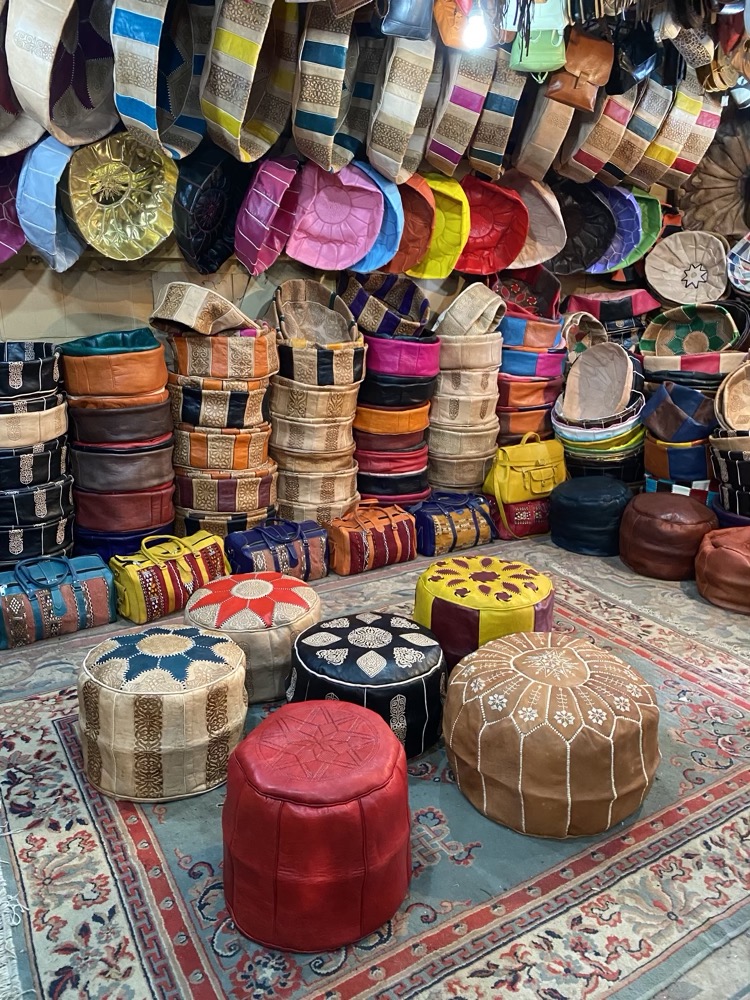
 Deep in the heart of the medina is the Zaouia of Moulay Idriss II religious complex. It’s a shrine, a mosque and temple dedicated to the tomb of Idris II who ruled Morocco from 807 to 828 (or Moulay Idris II when you include his sharifian title). He was considered the founder of the city of Fes and the first Moroccan Islamic state. The shrine is UNESCO listed and is one of the holiest shrines in Morocco.
Deep in the heart of the medina is the Zaouia of Moulay Idriss II religious complex. It’s a shrine, a mosque and temple dedicated to the tomb of Idris II who ruled Morocco from 807 to 828 (or Moulay Idris II when you include his sharifian title). He was considered the founder of the city of Fes and the first Moroccan Islamic state. The shrine is UNESCO listed and is one of the holiest shrines in Morocco.
 Men performing their ablutions prior to prayer.
Men performing their ablutions prior to prayer. There are multiple doors to the enormous religious complex and madras (religious university) which allow glimpses of life inside.
There are multiple doors to the enormous religious complex and madras (religious university) which allow glimpses of life inside. After this we took a well earned break for lunch – we had been walking the medina for a hectic three and a half hours… hectic because the place is packed shoulder to shoulder/cheek to jowl in many places. The ground is uneven and often slippery, it’s winding and there are ramps up and down all over the place, it’s easy to get lost and/or trampled by oncoming donkeys or men with handcarts. There is no dwardling in the medina without creating a traffic hazzard. It literally feels like there is no place to ‘be’ most of the time.
After this we took a well earned break for lunch – we had been walking the medina for a hectic three and a half hours… hectic because the place is packed shoulder to shoulder/cheek to jowl in many places. The ground is uneven and often slippery, it’s winding and there are ramps up and down all over the place, it’s easy to get lost and/or trampled by oncoming donkeys or men with handcarts. There is no dwardling in the medina without creating a traffic hazzard. It literally feels like there is no place to ‘be’ most of the time.
We went to a restaurant for lunch, called ‘Le Patio Bleu’ – there is plenty of delicious looking very cheap street food in the medina, but with a fairly long bus trip lined up for tomorrow, there’s no way I was going to risk that! So clean bathrooms and a higher probability of decent food handling practices were a priority. We had a wonderful lunch with a few of the other people in the group… starting with colourful ‘salads’ (a salad here appears to be any dish that consists of putting things together and can be hot or cold and huge or tiny?!).
 And also included some fabulous local dishes – a chicken pastille (chicken pie – shredded chicken with fruit and covered in cinamon and sugar), meatballs served with egg (this is rapidly turning into one of my fav Moroccan dishes), a beef tagine with almonds and prunes and some mixed grill skewers. Everything we’ve had here (with the exception of that first bland touristy restaurant) has been delicious.
And also included some fabulous local dishes – a chicken pastille (chicken pie – shredded chicken with fruit and covered in cinamon and sugar), meatballs served with egg (this is rapidly turning into one of my fav Moroccan dishes), a beef tagine with almonds and prunes and some mixed grill skewers. Everything we’ve had here (with the exception of that first bland touristy restaurant) has been delicious.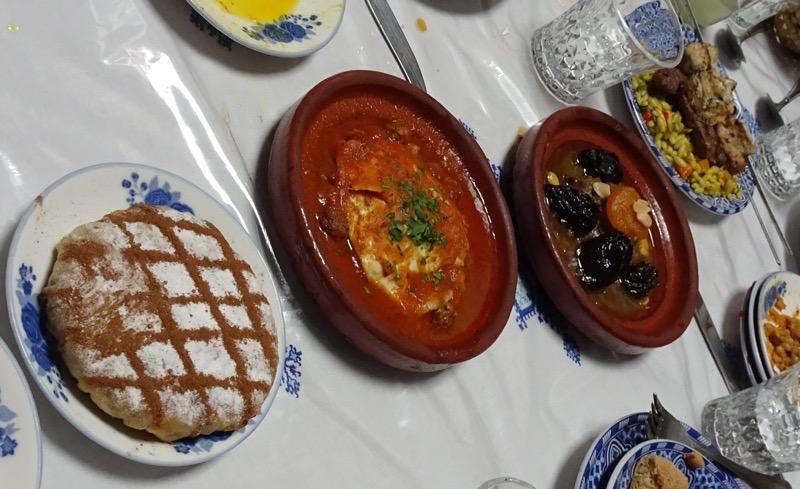 After a wonderful shared lunch, we ventured back into the medina to have a few more glimpses into the various gates leading to the mosque and mausoleum complex. The artwork and elaborate decoration on the doorways, walls everywhere you look is astounding.
After a wonderful shared lunch, we ventured back into the medina to have a few more glimpses into the various gates leading to the mosque and mausoleum complex. The artwork and elaborate decoration on the doorways, walls everywhere you look is astounding.





 There are public fountains scattered throughout the medina, and while the water is safe for locals, tourists generally don’t have the constitution to deal with it… so it’s best avoided.
There are public fountains scattered throughout the medina, and while the water is safe for locals, tourists generally don’t have the constitution to deal with it… so it’s best avoided.  Also connected to the mosque and mausoleaum complex is the University of al-Qarawiyyin which is THE oldest existing, continually operating higher educational institution in the world (according to both UNESCO and Guinness World Records). It was founded by in 859 AD with an associated madrasa, and subsequently became one of the leading spiritual and educational centers of the historic Muslim world. It was only incorporated into Morocco’s modern state university system in 1963, but has been a formal institute of learning that entire time.
Also connected to the mosque and mausoleaum complex is the University of al-Qarawiyyin which is THE oldest existing, continually operating higher educational institution in the world (according to both UNESCO and Guinness World Records). It was founded by in 859 AD with an associated madrasa, and subsequently became one of the leading spiritual and educational centers of the historic Muslim world. It was only incorporated into Morocco’s modern state university system in 1963, but has been a formal institute of learning that entire time.

 The small windows above are cells for the scholars who lived here… each has a bare room approximately 2m x 2m where they would dedicate themselves to Islamic religious and legal studies with a heavy emphasis on Classical Arabic grammar and linguistics and Maliki law. Some other non-Islamic studies are now also offered such as French and English.
The small windows above are cells for the scholars who lived here… each has a bare room approximately 2m x 2m where they would dedicate themselves to Islamic religious and legal studies with a heavy emphasis on Classical Arabic grammar and linguistics and Maliki law. Some other non-Islamic studies are now also offered such as French and English.



 We went upstairs to see the old student’s rooms, and were somewhat perturbed to notice that there were only locks on the doors on the outside of each room and small slots at eye level in each door… it felt more like a luxiourious detention centre than a student/monk’s type cell…?
We went upstairs to see the old student’s rooms, and were somewhat perturbed to notice that there were only locks on the doors on the outside of each room and small slots at eye level in each door… it felt more like a luxiourious detention centre than a student/monk’s type cell…?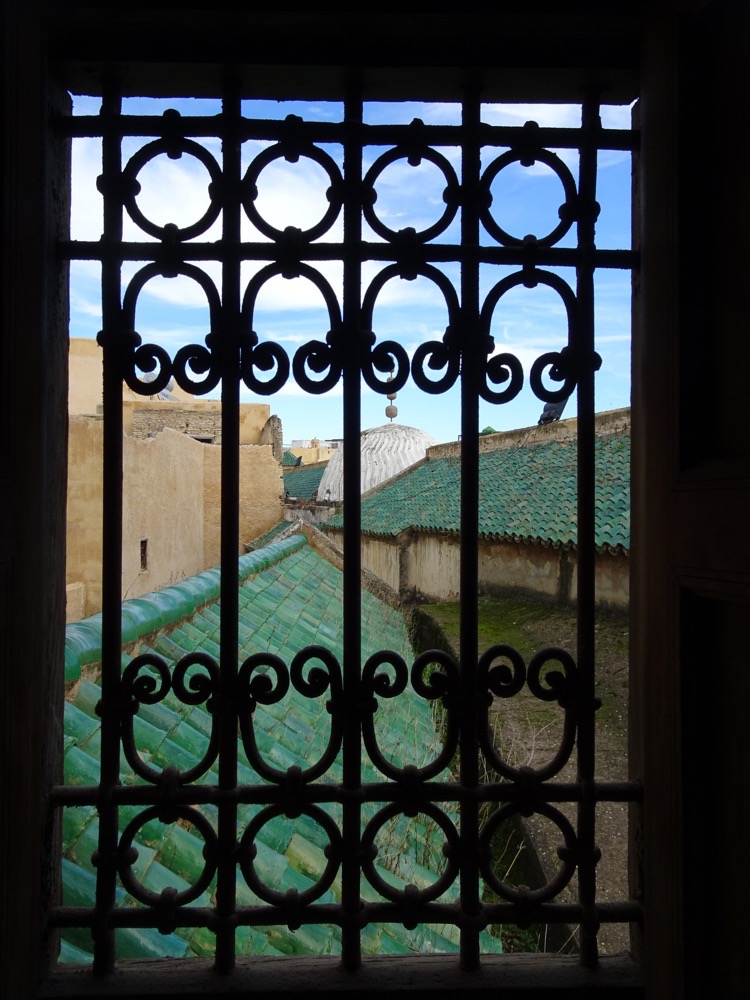 After our visit to the monastery, we made our way deep into the textiles sector of the medina – now THIS, I was really looking forward to. I was hoping to gain some insight into the sabra silk situation and find out whether it is made from the agave plant or no. We saw a demonstration of someone weaving on an old treadle loom, and the man who seemed to run/own the shop handed around pieces of agave and told us the sabra silk is made from agave fibres. It certainly seems fibrous enough to create a thread – but we weren’t offered any more information than that. From there it was ‘on with the hard sell’, which was a bit unfortunate as we hadn’t experienced this in the ceramics workshop or the tannery.
After our visit to the monastery, we made our way deep into the textiles sector of the medina – now THIS, I was really looking forward to. I was hoping to gain some insight into the sabra silk situation and find out whether it is made from the agave plant or no. We saw a demonstration of someone weaving on an old treadle loom, and the man who seemed to run/own the shop handed around pieces of agave and told us the sabra silk is made from agave fibres. It certainly seems fibrous enough to create a thread – but we weren’t offered any more information than that. From there it was ‘on with the hard sell’, which was a bit unfortunate as we hadn’t experienced this in the ceramics workshop or the tannery.  The ‘sabra silk’ items were mostly tablecloths and other durable items that most definitely felt somewhat ‘plasticy’ so I dare say it was all rayon and roughly woven at that. There was also loads and loads of pashmina and various garments, huge cotton tassels – no doubt all of which was imported.
The ‘sabra silk’ items were mostly tablecloths and other durable items that most definitely felt somewhat ‘plasticy’ so I dare say it was all rayon and roughly woven at that. There was also loads and loads of pashmina and various garments, huge cotton tassels – no doubt all of which was imported. 
 I would have loved to had a good look around and dig into the piles and piles of fabric and textiles, but myself and two of the other women in the group were being harrassed by the men in the store and became extremely uncomfortable. Mr K literally had to physically insert himself between one lady and a man who was being decidedly agressive with one of our new friends. Oddly it was the only time all day that we had been creeped out and we all wanted to get out of there asap.
I would have loved to had a good look around and dig into the piles and piles of fabric and textiles, but myself and two of the other women in the group were being harrassed by the men in the store and became extremely uncomfortable. Mr K literally had to physically insert himself between one lady and a man who was being decidedly agressive with one of our new friends. Oddly it was the only time all day that we had been creeped out and we all wanted to get out of there asap.
I know if I had been wandering the medina by myself, without a guide, that the ‘creeped out’ by unwanted attention or overly pushy sales tactics would have happened numerous times before now – it was just totally unexpected when you’re in one of the stores chosen by the tour company to offer a safe and relaxed shopping experience. Having travelled to Turkey, Pakistan and other countries with these sorts of shopping environments, I am somewhat used to it and know how to deflect this sort of attention – but this was seriously creepy and I felt unsafe even though I was there with my husband and at least half a dozen other men from our tour. Not good at all – so we made a point of offering some feedback to Mustafa and Samirr. Turns out they knew who the men were (Mr K had the forethought to snap some photos) and they don’t even work in the shop, they are just friends who hang around. So they’re going to let the owner know that these men are literally driving away their trade – there’s no way I would have left there without a handful of pashmina (historically speaking, it seems a dead certainty) if we had felt comfortable and taken our time to shop around.
 After this we were pretty much all medina’d out. Some of our group went on their own to find some more shopping and hunt for bargains, and some of us head back to the hotel to rest our weary feet. All up, it was an amazing day with so many sights and so much to see, but now I’m fucking exhausted! So it was back to the hotel for me for a chill evening of writing.
After this we were pretty much all medina’d out. Some of our group went on their own to find some more shopping and hunt for bargains, and some of us head back to the hotel to rest our weary feet. All up, it was an amazing day with so many sights and so much to see, but now I’m fucking exhausted! So it was back to the hotel for me for a chill evening of writing.
Tomorrow is Christmas Day and we are heading to Chefchaouen – the Blue City.
 Our room is the bottom one here – we were given the top floor, but gave it to Tess and Karl when I decided I didn’t really feel like walking up six flights of stairs every time we came and went from our room.
Our room is the bottom one here – we were given the top floor, but gave it to Tess and Karl when I decided I didn’t really feel like walking up six flights of stairs every time we came and went from our room.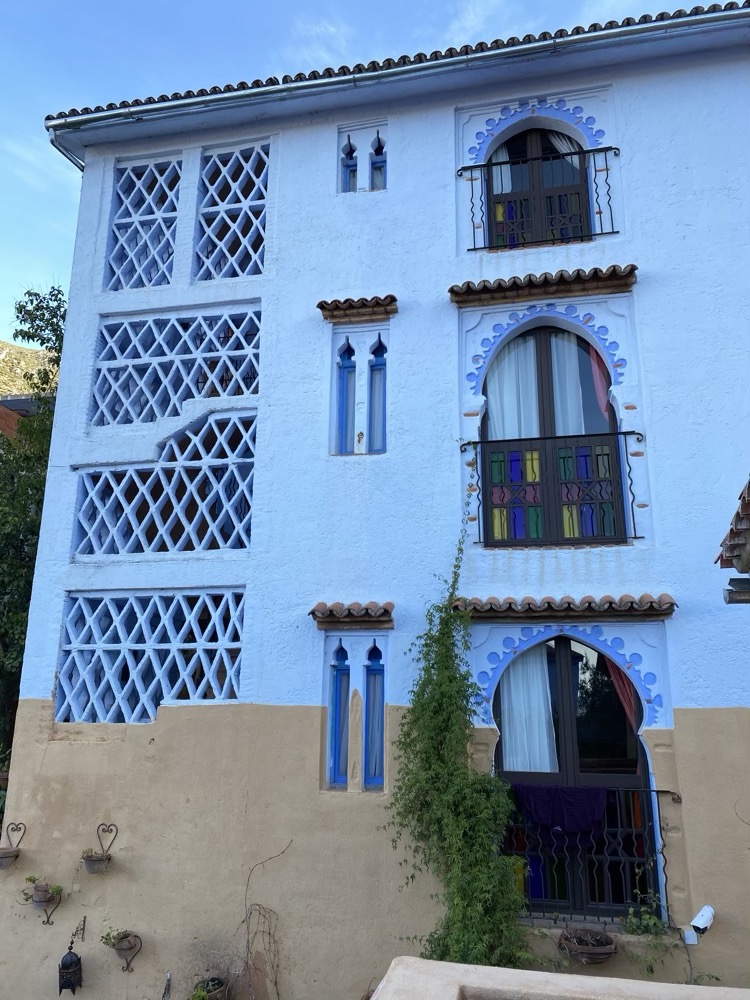 After breakfast, we ran into Jake and Tyson, who were chilling out using the wifi in a little fabric lined antechamber off the hotel lobby. They’re from California, both in college and travelling with their lovely grandparents, Chris and Allan. They’re really nice guys, though sometimes listening to how they talk to each other makes me laugh. They’re sure making themselves comfortable…
After breakfast, we ran into Jake and Tyson, who were chilling out using the wifi in a little fabric lined antechamber off the hotel lobby. They’re from California, both in college and travelling with their lovely grandparents, Chris and Allan. They’re really nice guys, though sometimes listening to how they talk to each other makes me laugh. They’re sure making themselves comfortable… 
 Christian may be the only person we beat to breakfast, he’s from Quebec, and here he is looking out over the view from the terrace restaurant.
Christian may be the only person we beat to breakfast, he’s from Quebec, and here he is looking out over the view from the terrace restaurant.
 On our way to the telco, we wandered through some more residential type areas, which were just as blue as the main touristy streets.
On our way to the telco, we wandered through some more residential type areas, which were just as blue as the main touristy streets. We met a lovely lady at the Maroc Telecom who was able to assist me with my 4G problem, in spite of my halting French. She told me that my SIM wasn’t properly activated and promptly fixed it. Service with a smile from a telco – who knew such things even existed? After we left there, we decided to take a taxi around to the top of the springs where we pretty much started yesterday’s walk – it wasn’t much farther than we had just come, but it was all uphill through the very winding streets, and today was supposed to be a chill day – so we shelled out the exorbitant AUD$3 for a Petit Taxi. Got to the top and there were men selling photos with their birds… I managed to sneak a picture of the guy’s peacock – but the guy standing beside an ostrich taller than he was, eluded me.
We met a lovely lady at the Maroc Telecom who was able to assist me with my 4G problem, in spite of my halting French. She told me that my SIM wasn’t properly activated and promptly fixed it. Service with a smile from a telco – who knew such things even existed? After we left there, we decided to take a taxi around to the top of the springs where we pretty much started yesterday’s walk – it wasn’t much farther than we had just come, but it was all uphill through the very winding streets, and today was supposed to be a chill day – so we shelled out the exorbitant AUD$3 for a Petit Taxi. Got to the top and there were men selling photos with their birds… I managed to sneak a picture of the guy’s peacock – but the guy standing beside an ostrich taller than he was, eluded me. And so we wandered through the narrow pedestrian walkways of the medina checking out the wares lining the streets… so many beautiful handmade things, so many beautiful blue alleys and so many very fancy doorways.
And so we wandered through the narrow pedestrian walkways of the medina checking out the wares lining the streets… so many beautiful handmade things, so many beautiful blue alleys and so many very fancy doorways. If felt like there were fewer people around this morning than yesterday evening – not sure if that was the case or if it was because we were trying to wander through the backstreets a bit more, but every time we stumbled back onto the main thoroughfares, it was not particularly crowded.
If felt like there were fewer people around this morning than yesterday evening – not sure if that was the case or if it was because we were trying to wander through the backstreets a bit more, but every time we stumbled back onto the main thoroughfares, it was not particularly crowded.
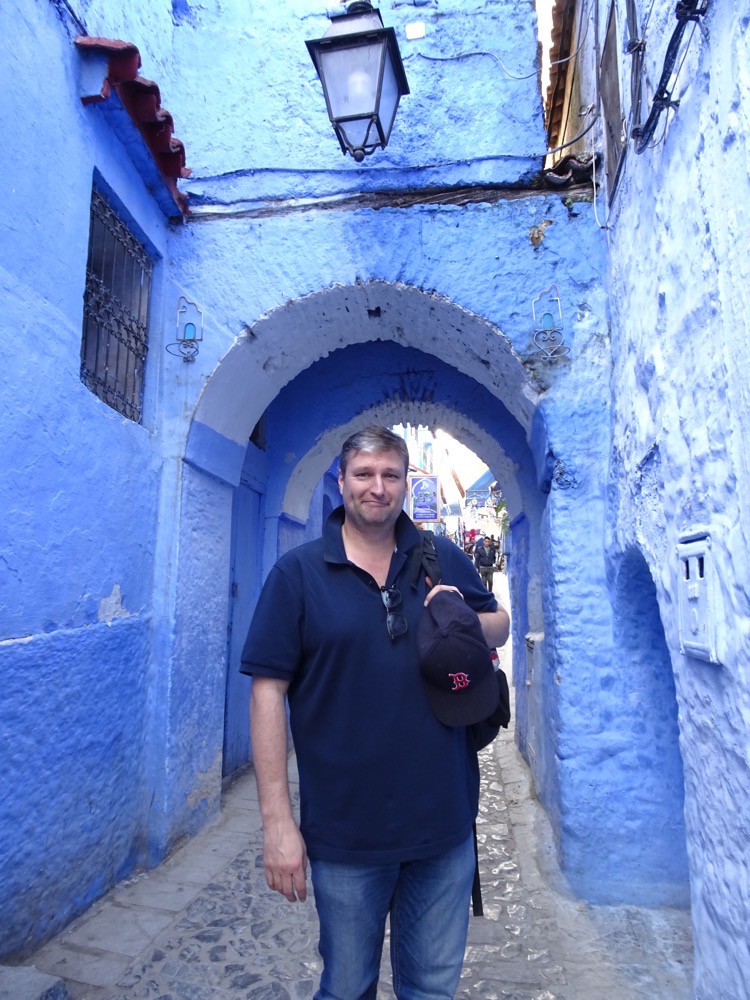

 Very fancy and intricate painting on these doors… my image shrinker has lost a lot of the detail, unfortunately.
Very fancy and intricate painting on these doors… my image shrinker has lost a lot of the detail, unfortunately.  Souvenir hand-embroidered cloths.
Souvenir hand-embroidered cloths. Me – standing in a very short, very blue, doorway.
Me – standing in a very short, very blue, doorway.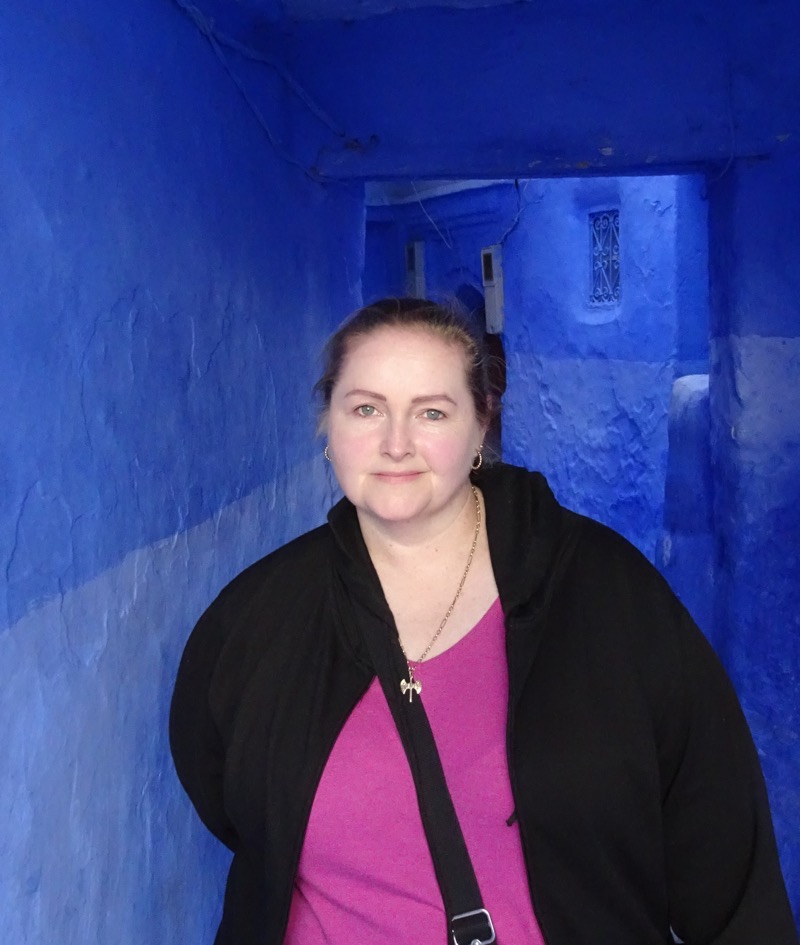
 There were so many very funky hand-knitted beanies everywhere, and I had to stop myself from buying some – but, I think I’ve finally learned my lesson. That lesson being – *You live in Brisbane and it’s rarely cold, you do not need twenty bloody woollen beanies collected from every weird place you go to!*. Well, at least the lesson seems to have held up for today, we will see if it makes it intact through the entire trip.
There were so many very funky hand-knitted beanies everywhere, and I had to stop myself from buying some – but, I think I’ve finally learned my lesson. That lesson being – *You live in Brisbane and it’s rarely cold, you do not need twenty bloody woollen beanies collected from every weird place you go to!*. Well, at least the lesson seems to have held up for today, we will see if it makes it intact through the entire trip.
 This fountain is fed from the beautiful fresh and clean spring that we went to yesterday, though I have no idea what they have been washing here to make it look so unappealing. Don’t care how clean the water is supposed to be, there’s no way I would fill my bottle from this fountain!
This fountain is fed from the beautiful fresh and clean spring that we went to yesterday, though I have no idea what they have been washing here to make it look so unappealing. Don’t care how clean the water is supposed to be, there’s no way I would fill my bottle from this fountain!
 Gorgeous altogether!
Gorgeous altogether!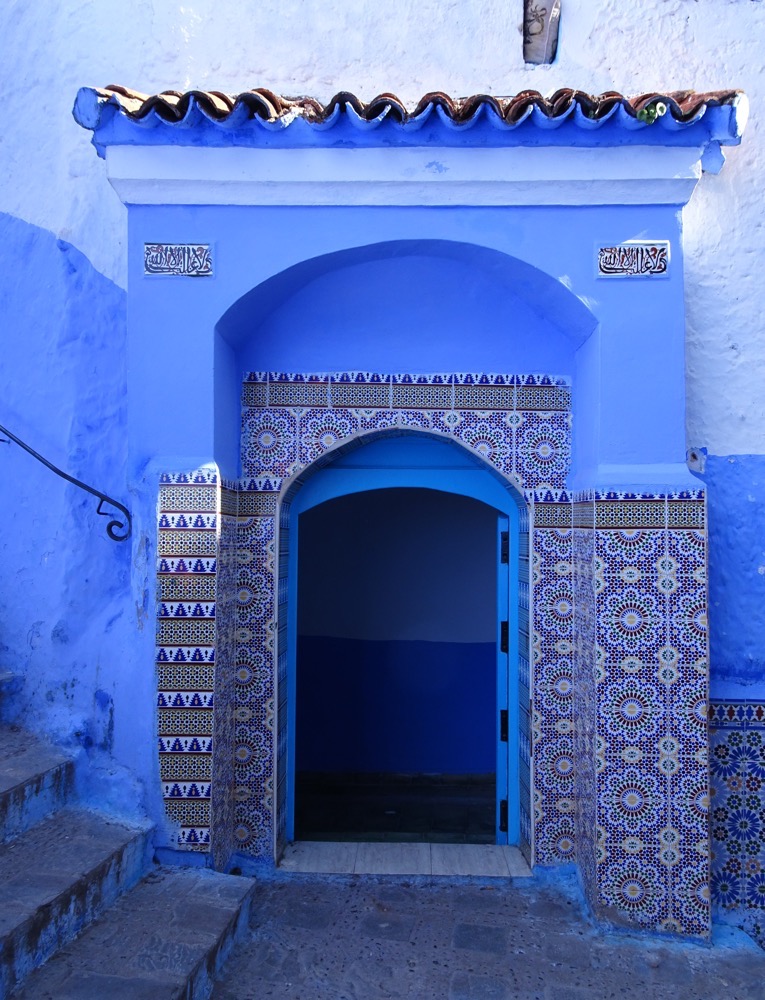

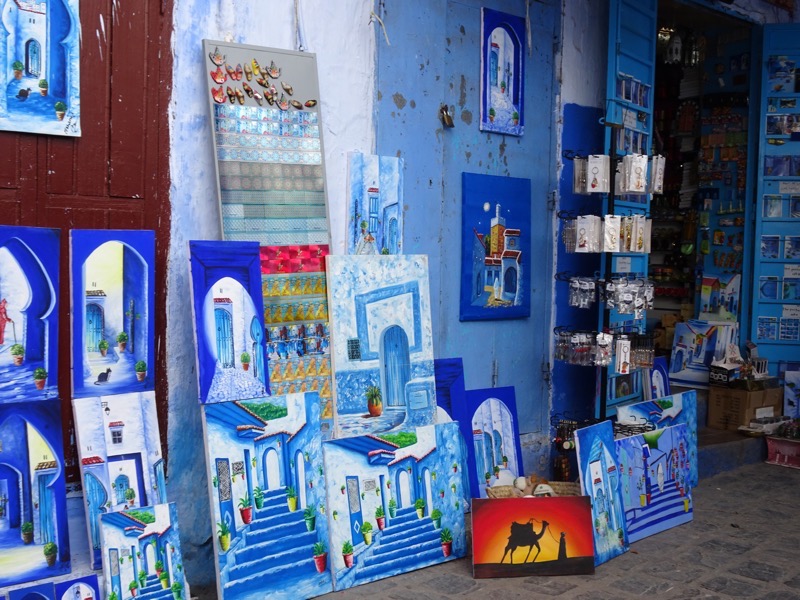
 In the back streets looking for interesting alleys and vistas and spied this very steep set of stairs… did a double-take and noticed this little guy:
In the back streets looking for interesting alleys and vistas and spied this very steep set of stairs… did a double-take and noticed this little guy: Sitting around like he owned the place.
Sitting around like he owned the place.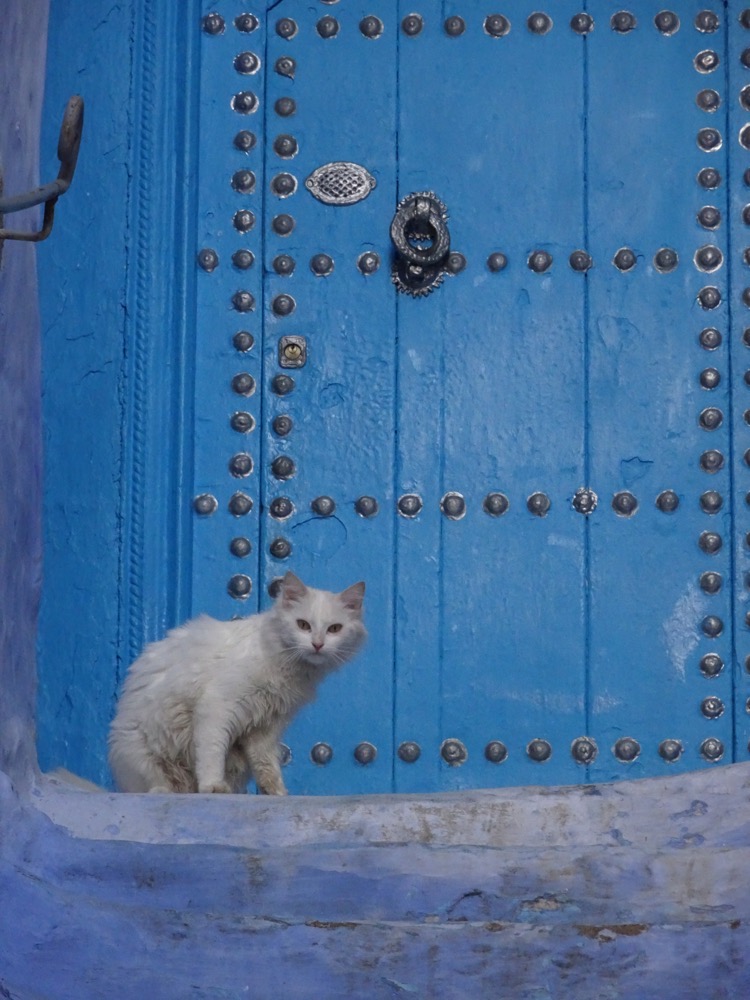
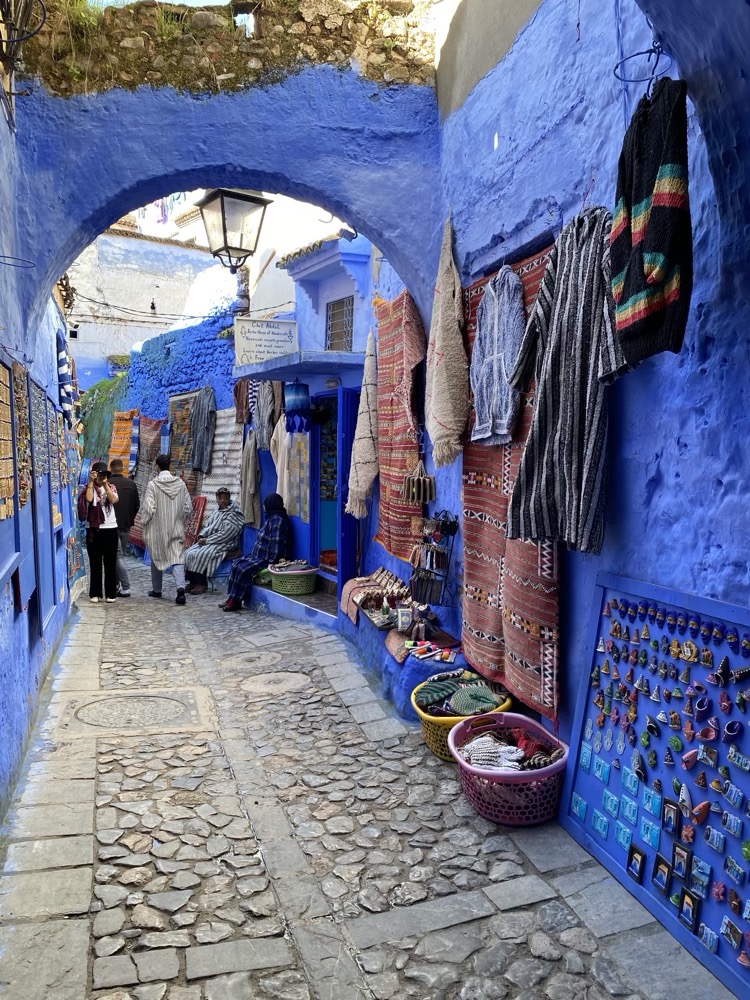
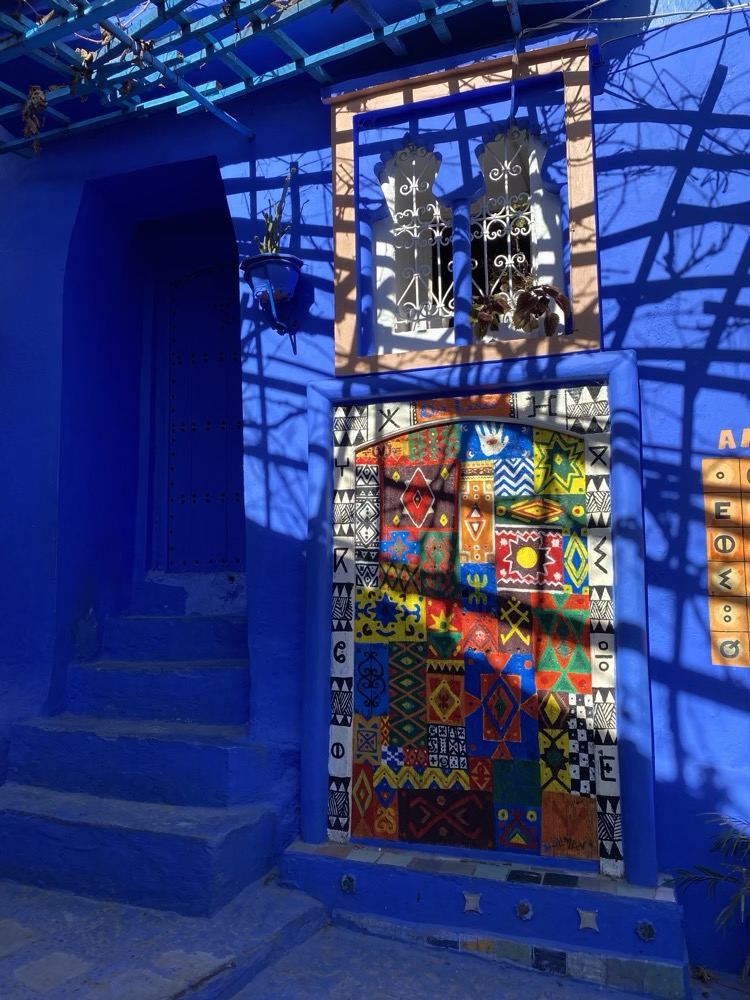 We stopped for lunch down in the main square. Coffee thick as mud, chicken shish, and kofka tagine. Doesn’t take long to decide you could sure get used to this – a long black, a lemon soft drink, two lovingly cooked and very tasty main meals served with free bread, and we were up for a hefty AUD$15.00.
We stopped for lunch down in the main square. Coffee thick as mud, chicken shish, and kofka tagine. Doesn’t take long to decide you could sure get used to this – a long black, a lemon soft drink, two lovingly cooked and very tasty main meals served with free bread, and we were up for a hefty AUD$15.00.

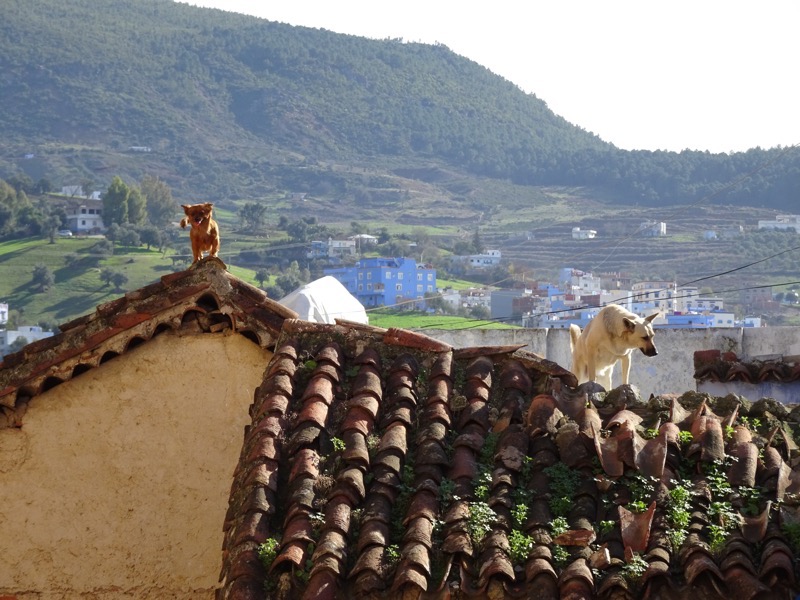
 Gorgeous facade on a local school:
Gorgeous facade on a local school: We then made our way into the Kasbah to have a look around. The Kasbah in Chefchaouen was built in the 15thC and in contast to the blue city, it is terracotta-brown in appearance.
We then made our way into the Kasbah to have a look around. The Kasbah in Chefchaouen was built in the 15thC and in contast to the blue city, it is terracotta-brown in appearance. 
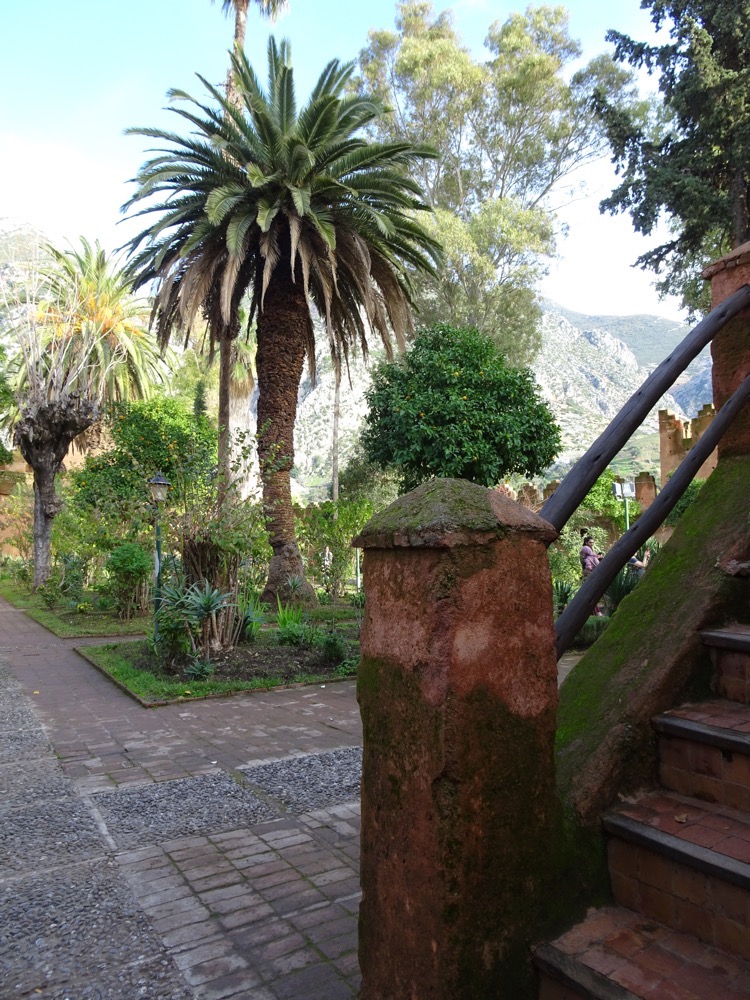 The Chefchaouen Kasbah contains a lovely Andalusian-style garden and a former prison.
The Chefchaouen Kasbah contains a lovely Andalusian-style garden and a former prison. This prision reminds me of the one Kevin Costner finds himself detained in when captured by the Moors while on Crusade in the terribly historically inaccurate, but somewhat lovealbe film, (thanks Alan Rickman) Robin Hood Prince of Thieves (c.1990 something).
This prision reminds me of the one Kevin Costner finds himself detained in when captured by the Moors while on Crusade in the terribly historically inaccurate, but somewhat lovealbe film, (thanks Alan Rickman) Robin Hood Prince of Thieves (c.1990 something).


 Looking out from the prison to the Andaluscian gardens.
Looking out from the prison to the Andaluscian gardens.  Amazingly there are at least half a dozen huge and very established gum trees in the garden. They might seem like a good idea, but I have a feeling if one of them comes down, they are giong to create one helluva mess of the ancient walls.
Amazingly there are at least half a dozen huge and very established gum trees in the garden. They might seem like a good idea, but I have a feeling if one of them comes down, they are giong to create one helluva mess of the ancient walls. 
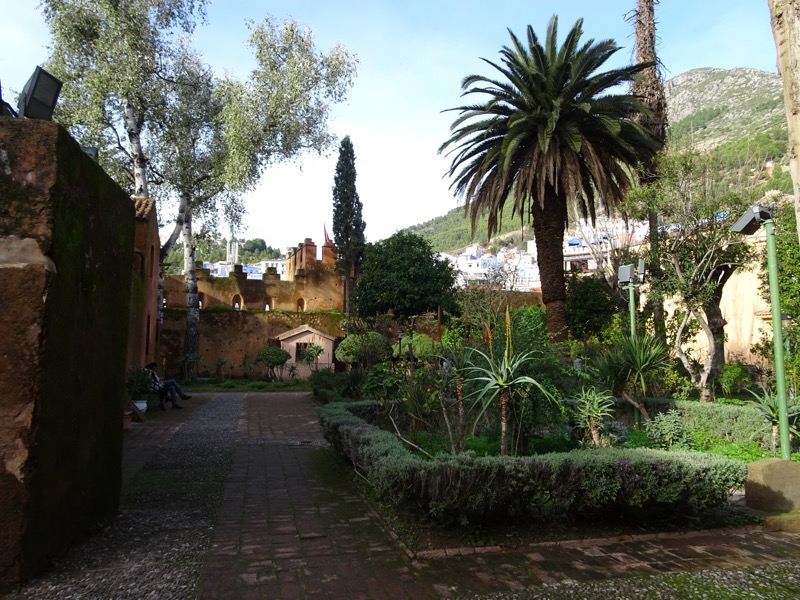

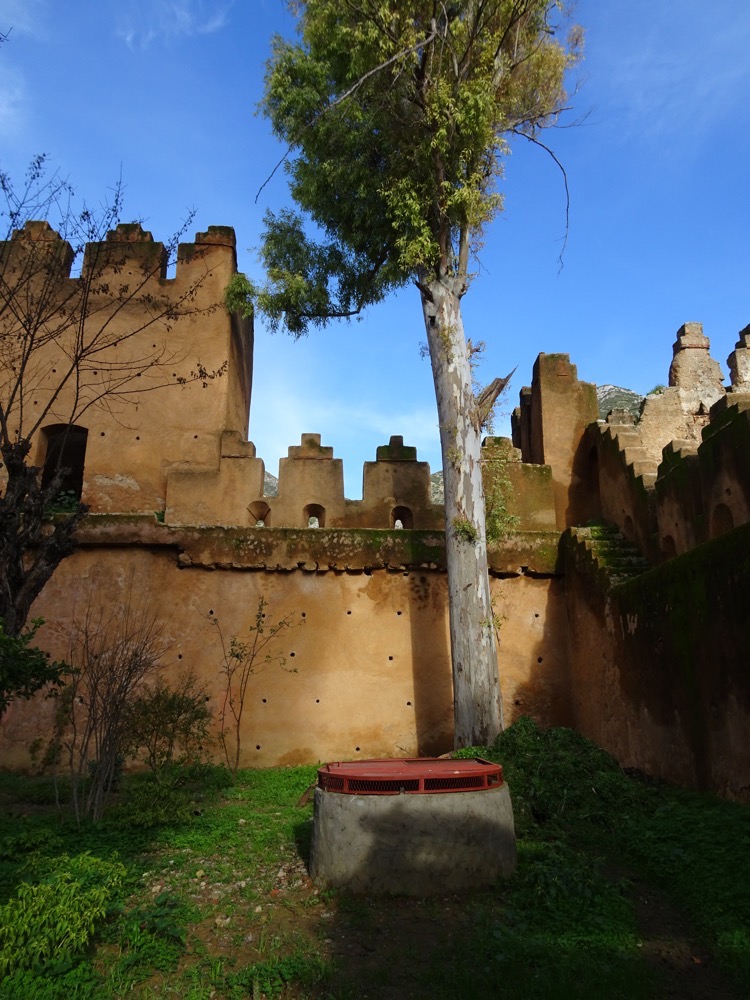

 The Center for Research and Andalusian Studies is also here and currently undergoing renovations, so we could only see the lower levels at the moment.
The Center for Research and Andalusian Studies is also here and currently undergoing renovations, so we could only see the lower levels at the moment.
 After that it was back through the mall by which time the buskers, touts, and generally annoying people trying to get your money had all started to turn out, and we decided it was time to head back to the hotel for a bit of rest before dinner with whoever turned out to be around at the time.
After that it was back through the mall by which time the buskers, touts, and generally annoying people trying to get your money had all started to turn out, and we decided it was time to head back to the hotel for a bit of rest before dinner with whoever turned out to be around at the time. 

 The royal palace is a popular tourist stop for its enormous ornate bronze doors in gates heavily decorated with zellige tilework and carved cedarwood. The innumerable hours of hand-craftsmanship that goes into making these things is simply phenomenal.
The royal palace is a popular tourist stop for its enormous ornate bronze doors in gates heavily decorated with zellige tilework and carved cedarwood. The innumerable hours of hand-craftsmanship that goes into making these things is simply phenomenal.


 Zellige is mosaic tilework technique that is achieved by taking individually chiselled geometric tiles and then setting them into a plaster base (for certain purposes, like small fountains, they use fibreglass to set them into place. It’s a really popular and prevalent form of Islamic art that we’ve seen replicated on a lot of Moroccan architecture. The geometric patterns are really appealing and you see them on walls, ceilings, fountains, floors, pools and tables.
Zellige is mosaic tilework technique that is achieved by taking individually chiselled geometric tiles and then setting them into a plaster base (for certain purposes, like small fountains, they use fibreglass to set them into place. It’s a really popular and prevalent form of Islamic art that we’ve seen replicated on a lot of Moroccan architecture. The geometric patterns are really appealing and you see them on walls, ceilings, fountains, floors, pools and tables. 
 Off to the left of this main gate is a small ‘servants entrance’… frankly, they probably deserve to use the main entrance seeing they come and go way more than the King!
Off to the left of this main gate is a small ‘servants entrance’… frankly, they probably deserve to use the main entrance seeing they come and go way more than the King!



 After a quick wander through the Jewish Quarter, we took a drive out to a lookout to have a look at the city of Fez. Fez is Morocco’s second largest city, behind Casablanca, with 1.4million peoples. It is largely locaed in a valley surrounded by the high grounds, and the old city or the Medina is divided by the River Fez which runs through the 9thC walled part of the city.
After a quick wander through the Jewish Quarter, we took a drive out to a lookout to have a look at the city of Fez. Fez is Morocco’s second largest city, behind Casablanca, with 1.4million peoples. It is largely locaed in a valley surrounded by the high grounds, and the old city or the Medina is divided by the River Fez which runs through the 9thC walled part of the city. These pictures show how closely packed the Fez Medina is – it is believed to be the largest pedestrian zone in the world. Not a single vehicle can enter the medina as it is a completely bamboozling labyrinth of winding alleyways some of which are barely 70cm wide. Donkeys, mules and horses are the only form of transport in the medina and everything is transported in via animal or hand cart.
These pictures show how closely packed the Fez Medina is – it is believed to be the largest pedestrian zone in the world. Not a single vehicle can enter the medina as it is a completely bamboozling labyrinth of winding alleyways some of which are barely 70cm wide. Donkeys, mules and horses are the only form of transport in the medina and everything is transported in via animal or hand cart. Walls of the Fez Medina…the holes in the walls are desinged to allow the high wind to pass through the walls rather than causing damage. Apparently the wind here gets so bad it can ‘knock over’ wall like this…
Walls of the Fez Medina…the holes in the walls are desinged to allow the high wind to pass through the walls rather than causing damage. Apparently the wind here gets so bad it can ‘knock over’ wall like this… Before we threw caution to the aforemented wind and ventured into the Medina, we took a stop at a local mosaic and ceramic factory. Pictoral mosaics like the one below are not particularly common. Usually you see the traditional geometric, typically Islamic styles of art still being replicated in mosaic work.
Before we threw caution to the aforemented wind and ventured into the Medina, we took a stop at a local mosaic and ceramic factory. Pictoral mosaics like the one below are not particularly common. Usually you see the traditional geometric, typically Islamic styles of art still being replicated in mosaic work. Piles of clay come straight from quarries and have zero purification or cleansing before being put to use.
Piles of clay come straight from quarries and have zero purification or cleansing before being put to use. 

 Turned bowls drying before their first firing.
Turned bowls drying before their first firing. The kilns used are still traditional kilns that have been used for hundreds of years… the ground up dark dirt seen in the front is actually ground up olive pits which are added to the kiln fires. Something to do with the oils being beneficial in the firing process, but I’ll admit the explanation was a bit disjointed.
The kilns used are still traditional kilns that have been used for hundreds of years… the ground up dark dirt seen in the front is actually ground up olive pits which are added to the kiln fires. Something to do with the oils being beneficial in the firing process, but I’ll admit the explanation was a bit disjointed.  Tile making in action – this guys spends all day making clay squares into more uniform, flat and tapered clay squares. :/
Tile making in action – this guys spends all day making clay squares into more uniform, flat and tapered clay squares. :/ 
 Painting the ceramics with glaze before the second firing.
Painting the ceramics with glaze before the second firing. Etching off the glaze before a second glaze is done.
Etching off the glaze before a second glaze is done. 


 Mosaic work is painstakingly done by hand. From the drawing of the designs onto the nice square tiles the previous guy was making…
Mosaic work is painstakingly done by hand. From the drawing of the designs onto the nice square tiles the previous guy was making…
 To the laying out of the design – upside down so the plaster can be poured onto the back to hold it together!
To the laying out of the design – upside down so the plaster can be poured onto the back to hold it together! To the final chiselling of the finished product to clean up any irregular edges or overflowed plaster.
To the final chiselling of the finished product to clean up any irregular edges or overflowed plaster. The end results of this meticulous and time consuming work are amazingly beautful artworks.
The end results of this meticulous and time consuming work are amazingly beautful artworks.









 The World Heritage listed Fez al Bali Medina has alleys coming off alleys,stemming from alleys that are connected to even more alleys. Nearly all tourists who venture into this place come with a guide of some sort, becuase it is so easy to get completely lost and end up wandering around for kilometres to find your way out. We entered near a food section of covered markets.
The World Heritage listed Fez al Bali Medina has alleys coming off alleys,stemming from alleys that are connected to even more alleys. Nearly all tourists who venture into this place come with a guide of some sort, becuase it is so easy to get completely lost and end up wandering around for kilometres to find your way out. We entered near a food section of covered markets.  Dates, figs, seafood, meat, fresh fruits and vegetables, tea, grains, spices, herbs, and god knows what else was stashed into every available square inch of space in the covered shops. It is very similar to the Grand Bazaar in Isanbul.
Dates, figs, seafood, meat, fresh fruits and vegetables, tea, grains, spices, herbs, and god knows what else was stashed into every available square inch of space in the covered shops. It is very similar to the Grand Bazaar in Isanbul.  This man was selling live snails, and when he saw the tourists photographing his big tub of slimy delicacies, he started asking for money from people who shoved their cameras right over the tub of writhing creatures… tourists in the medina taking lots of photos and buying no produce must drive them crazy.
This man was selling live snails, and when he saw the tourists photographing his big tub of slimy delicacies, he started asking for money from people who shoved their cameras right over the tub of writhing creatures… tourists in the medina taking lots of photos and buying no produce must drive them crazy. The camel heads hanging at the butcher’s shop is apparently the easiest way to tell people that you have camel meat in stock today. Little gory, definitely effective advertising.
The camel heads hanging at the butcher’s shop is apparently the easiest way to tell people that you have camel meat in stock today. Little gory, definitely effective advertising.  Seafoods – the large lumps of white flesh in the front of the table is some sort of local shark meat.
Seafoods – the large lumps of white flesh in the front of the table is some sort of local shark meat. Not far from the fresh produce and food stuffs are was dyers lane. I could see all this silk hanging up and it piqued my interest immediately. Apparently this is ‘saba silk’, which allegedly comes from the agave cactus plant – yes, that agave plant. Disappointinly, from what I’ve read up on this thread though, the bulk of the ‘saba silk’ used in Morrocan crafts is actually rayon that has been manufactured in Spain or India and comes in bulk and is dyed here for local use. I don’t think people care that their item has rayon embroidery on it – but generally speaking I don’t think it’s ethical to lead people to think that their item is made from hand harvested agave and spun by local women into something beautiful, when it’s actually brough in pre-manufactured from India. This is one of those things you hear about and think: ‘yeah, not entirely surprised’.
Not far from the fresh produce and food stuffs are was dyers lane. I could see all this silk hanging up and it piqued my interest immediately. Apparently this is ‘saba silk’, which allegedly comes from the agave cactus plant – yes, that agave plant. Disappointinly, from what I’ve read up on this thread though, the bulk of the ‘saba silk’ used in Morrocan crafts is actually rayon that has been manufactured in Spain or India and comes in bulk and is dyed here for local use. I don’t think people care that their item has rayon embroidery on it – but generally speaking I don’t think it’s ethical to lead people to think that their item is made from hand harvested agave and spun by local women into something beautiful, when it’s actually brough in pre-manufactured from India. This is one of those things you hear about and think: ‘yeah, not entirely surprised’.  Just outside the dyer’s lane was a small bridge that gave a view of the Fez River which runs thorugh the medina. It’s difficult to see in this photo with such a high contrast ration, but I can tell you unequivocally that the fish and eel and other seafood stuffs being sold inside, does NOT come from this river.
Just outside the dyer’s lane was a small bridge that gave a view of the Fez River which runs thorugh the medina. It’s difficult to see in this photo with such a high contrast ration, but I can tell you unequivocally that the fish and eel and other seafood stuffs being sold inside, does NOT come from this river. We saw loads of these large cone shaped items around the place and had to ask Mustafa what they were – they are food coverings, and apparently these huge velvet and embroidered ones are used for covering bread… ’tis a far cry from the Brabante bread bin that adorns my kitchen!
We saw loads of these large cone shaped items around the place and had to ask Mustafa what they were – they are food coverings, and apparently these huge velvet and embroidered ones are used for covering bread… ’tis a far cry from the Brabante bread bin that adorns my kitchen!








 I managed to see another man doing some metal work on one of these metal topped tables, and was just amazed at how detailed they were.
I managed to see another man doing some metal work on one of these metal topped tables, and was just amazed at how detailed they were. Further into the the medina we found ourselves moving into the leather area. Morocco is famous for its leather industry, and the medina has three tanneries contained within its walls.
Further into the the medina we found ourselves moving into the leather area. Morocco is famous for its leather industry, and the medina has three tanneries contained within its walls.

 From a balcony overlooking the tannery, you can see numerous stone pits filled with different coloured dyes and liquids. Hides of cows, sheep, goats, and camels are processed here – the first step is to soak them in a series of white liquids – this first stage of the process uses a liquid that is a varying mixture of cow urine, pigeon shit, quicklime, salt, and water. This cleans the often very tough skins, and it normally takes about two or three days. After the cleaning and scraping, they are soaked in various dyeing solutions. The tannery uses many natural colourants such as poppy for red, indigo for blue, and henna for orange – same as they have used since the 11thC. After the skins are dyed, they get spread out on rooftops for sun drying. The leather then gets sold to various craftsmen who use it to make Morocco’s famous leather goods: bags, coats, shoes, and slippers. The entire leather production process in Morocco is done completely by manual labour and uses no modern machinery. They have retained methods that are unchanged since the medieval period… which is just amazing but also completely nuts.
From a balcony overlooking the tannery, you can see numerous stone pits filled with different coloured dyes and liquids. Hides of cows, sheep, goats, and camels are processed here – the first step is to soak them in a series of white liquids – this first stage of the process uses a liquid that is a varying mixture of cow urine, pigeon shit, quicklime, salt, and water. This cleans the often very tough skins, and it normally takes about two or three days. After the cleaning and scraping, they are soaked in various dyeing solutions. The tannery uses many natural colourants such as poppy for red, indigo for blue, and henna for orange – same as they have used since the 11thC. After the skins are dyed, they get spread out on rooftops for sun drying. The leather then gets sold to various craftsmen who use it to make Morocco’s famous leather goods: bags, coats, shoes, and slippers. The entire leather production process in Morocco is done completely by manual labour and uses no modern machinery. They have retained methods that are unchanged since the medieval period… which is just amazing but also completely nuts.

 Thank the gods for that spring of mint – the stench was enough to turn your stomcah. I can’t imagine how anyone survives a visit up here in the summer, and I really don’t know how anyone survives working down there their whole life!
Thank the gods for that spring of mint – the stench was enough to turn your stomcah. I can’t imagine how anyone survives a visit up here in the summer, and I really don’t know how anyone survives working down there their whole life!



 I love all these colourful ottomans… you buy them unstuffed and take them home and can stuf them with wadding, wool, rags, hair, whaterver you want. They’re not particularly small to transport though.
I love all these colourful ottomans… you buy them unstuffed and take them home and can stuf them with wadding, wool, rags, hair, whaterver you want. They’re not particularly small to transport though.
 Deep in the heart of the medina is the Zaouia of Moulay Idriss II religious complex. It’s a shrine, a mosque and temple dedicated to the tomb of Idris II who ruled Morocco from 807 to 828 (or Moulay Idris II when you include his sharifian title). He was considered the founder of the city of Fes and the first Moroccan Islamic state. The shrine is UNESCO listed and is one of the holiest shrines in Morocco.
Deep in the heart of the medina is the Zaouia of Moulay Idriss II religious complex. It’s a shrine, a mosque and temple dedicated to the tomb of Idris II who ruled Morocco from 807 to 828 (or Moulay Idris II when you include his sharifian title). He was considered the founder of the city of Fes and the first Moroccan Islamic state. The shrine is UNESCO listed and is one of the holiest shrines in Morocco.
 Men performing their ablutions prior to prayer.
Men performing their ablutions prior to prayer. There are multiple doors to the enormous religious complex and madras (religious university) which allow glimpses of life inside.
There are multiple doors to the enormous religious complex and madras (religious university) which allow glimpses of life inside. After this we took a well earned break for lunch – we had been walking the medina for a hectic three and a half hours… hectic because the place is packed shoulder to shoulder/cheek to jowl in many places. The ground is uneven and often slippery, it’s winding and there are ramps up and down all over the place, it’s easy to get lost and/or trampled by oncoming donkeys or men with handcarts. There is no dwardling in the medina without creating a traffic hazzard. It literally feels like there is no place to ‘be’ most of the time.
After this we took a well earned break for lunch – we had been walking the medina for a hectic three and a half hours… hectic because the place is packed shoulder to shoulder/cheek to jowl in many places. The ground is uneven and often slippery, it’s winding and there are ramps up and down all over the place, it’s easy to get lost and/or trampled by oncoming donkeys or men with handcarts. There is no dwardling in the medina without creating a traffic hazzard. It literally feels like there is no place to ‘be’ most of the time. And also included some fabulous local dishes – a chicken pastille (chicken pie – shredded chicken with fruit and covered in cinamon and sugar), meatballs served with egg (this is rapidly turning into one of my fav Moroccan dishes), a beef tagine with almonds and prunes and some mixed grill skewers. Everything we’ve had here (with the exception of that first bland touristy restaurant) has been delicious.
And also included some fabulous local dishes – a chicken pastille (chicken pie – shredded chicken with fruit and covered in cinamon and sugar), meatballs served with egg (this is rapidly turning into one of my fav Moroccan dishes), a beef tagine with almonds and prunes and some mixed grill skewers. Everything we’ve had here (with the exception of that first bland touristy restaurant) has been delicious. After a wonderful shared lunch, we ventured back into the medina to have a few more glimpses into the various gates leading to the mosque and mausoleum complex. The artwork and elaborate decoration on the doorways, walls everywhere you look is astounding.
After a wonderful shared lunch, we ventured back into the medina to have a few more glimpses into the various gates leading to the mosque and mausoleum complex. The artwork and elaborate decoration on the doorways, walls everywhere you look is astounding.





 There are public fountains scattered throughout the medina, and while the water is safe for locals, tourists generally don’t have the constitution to deal with it… so it’s best avoided.
There are public fountains scattered throughout the medina, and while the water is safe for locals, tourists generally don’t have the constitution to deal with it… so it’s best avoided.  Also connected to the mosque and mausoleaum complex is the University of al-Qarawiyyin which is THE oldest existing, continually operating higher educational institution in the world (according to both UNESCO and Guinness World Records). It was founded by in 859 AD with an associated madrasa, and subsequently became one of the leading spiritual and educational centers of the historic Muslim world. It was only incorporated into Morocco’s modern state university system in 1963, but has been a formal institute of learning that entire time.
Also connected to the mosque and mausoleaum complex is the University of al-Qarawiyyin which is THE oldest existing, continually operating higher educational institution in the world (according to both UNESCO and Guinness World Records). It was founded by in 859 AD with an associated madrasa, and subsequently became one of the leading spiritual and educational centers of the historic Muslim world. It was only incorporated into Morocco’s modern state university system in 1963, but has been a formal institute of learning that entire time.

 The small windows above are cells for the scholars who lived here… each has a bare room approximately 2m x 2m where they would dedicate themselves to Islamic religious and legal studies with a heavy emphasis on Classical Arabic grammar and linguistics and Maliki law. Some other non-Islamic studies are now also offered such as French and English.
The small windows above are cells for the scholars who lived here… each has a bare room approximately 2m x 2m where they would dedicate themselves to Islamic religious and legal studies with a heavy emphasis on Classical Arabic grammar and linguistics and Maliki law. Some other non-Islamic studies are now also offered such as French and English.



 We went upstairs to see the old student’s rooms, and were somewhat perturbed to notice that there were only locks on the doors on the outside of each room and small slots at eye level in each door… it felt more like a luxiourious detention centre than a student/monk’s type cell…?
We went upstairs to see the old student’s rooms, and were somewhat perturbed to notice that there were only locks on the doors on the outside of each room and small slots at eye level in each door… it felt more like a luxiourious detention centre than a student/monk’s type cell…? After our visit to the monastery, we made our way deep into the textiles sector of the medina – now THIS, I was really looking forward to. I was hoping to gain some insight into the sabra silk situation and find out whether it is made from the agave plant or no. We saw a demonstration of someone weaving on an old treadle loom, and the man who seemed to run/own the shop handed around pieces of agave and told us the sabra silk is made from agave fibres. It certainly seems fibrous enough to create a thread – but we weren’t offered any more information than that. From there it was ‘on with the hard sell’, which was a bit unfortunate as we hadn’t experienced this in the ceramics workshop or the tannery.
After our visit to the monastery, we made our way deep into the textiles sector of the medina – now THIS, I was really looking forward to. I was hoping to gain some insight into the sabra silk situation and find out whether it is made from the agave plant or no. We saw a demonstration of someone weaving on an old treadle loom, and the man who seemed to run/own the shop handed around pieces of agave and told us the sabra silk is made from agave fibres. It certainly seems fibrous enough to create a thread – but we weren’t offered any more information than that. From there it was ‘on with the hard sell’, which was a bit unfortunate as we hadn’t experienced this in the ceramics workshop or the tannery.  The ‘sabra silk’ items were mostly tablecloths and other durable items that most definitely felt somewhat ‘plasticy’ so I dare say it was all rayon and roughly woven at that. There was also loads and loads of pashmina and various garments, huge cotton tassels – no doubt all of which was imported.
The ‘sabra silk’ items were mostly tablecloths and other durable items that most definitely felt somewhat ‘plasticy’ so I dare say it was all rayon and roughly woven at that. There was also loads and loads of pashmina and various garments, huge cotton tassels – no doubt all of which was imported. 

 After this we were pretty much all medina’d out. Some of our group went on their own to find some more shopping and hunt for bargains, and some of us head back to the hotel to rest our weary feet. All up, it was an amazing day with so many sights and so much to see, but now I’m fucking exhausted! So it was back to the hotel for me for a chill evening of writing.
After this we were pretty much all medina’d out. Some of our group went on their own to find some more shopping and hunt for bargains, and some of us head back to the hotel to rest our weary feet. All up, it was an amazing day with so many sights and so much to see, but now I’m fucking exhausted! So it was back to the hotel for me for a chill evening of writing.






 The Izmailovsky Markets are Moscow’s largest flea markets. With plenty of permanent vendors selling all the usual tourist offerings – dolls, furs, scarves, ceramics, wooden wares – right along side part-time or one-off vendors, selling collectable coins, military paraphernalia, tools, lapidary supplies, Soviet era memorabilia, gemstones and bayonets and spare magazines for your AK47.
The Izmailovsky Markets are Moscow’s largest flea markets. With plenty of permanent vendors selling all the usual tourist offerings – dolls, furs, scarves, ceramics, wooden wares – right along side part-time or one-off vendors, selling collectable coins, military paraphernalia, tools, lapidary supplies, Soviet era memorabilia, gemstones and bayonets and spare magazines for your AK47.






 So many dolls!
So many dolls!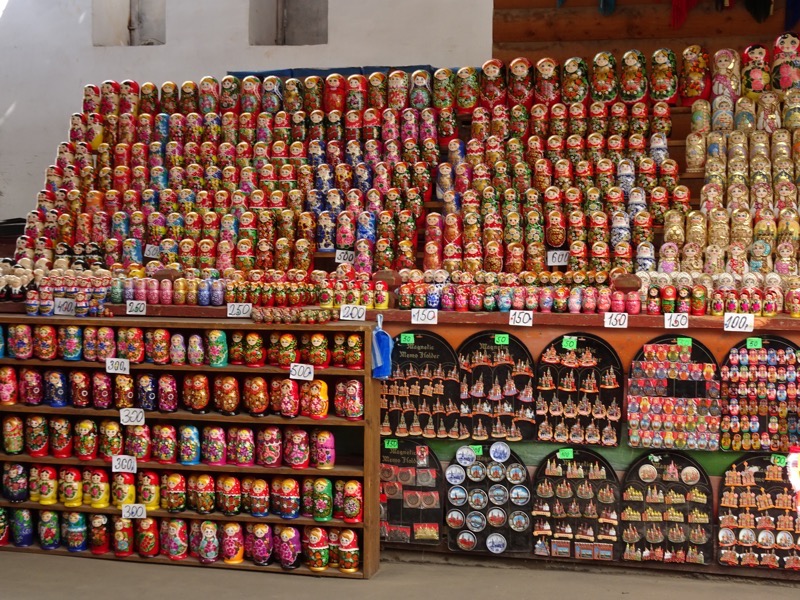






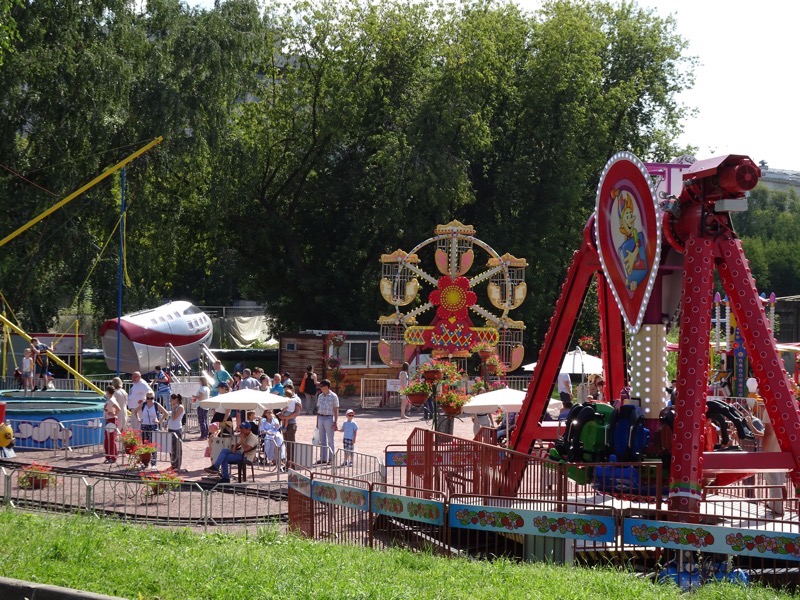

 Around the Central House of Artists are a number of these large pavillions where local artists are exhibiting and presumably selling their paintings. The artistic genres and styles vary as much as the subject matter, and it is a great place to see how Muscovites are interpreting and representing their experiences here. The artworks were very impressive, if they were not so annoying to transport home, I would have loved to have delved in and chosen a special piece.
Around the Central House of Artists are a number of these large pavillions where local artists are exhibiting and presumably selling their paintings. The artistic genres and styles vary as much as the subject matter, and it is a great place to see how Muscovites are interpreting and representing their experiences here. The artworks were very impressive, if they were not so annoying to transport home, I would have loved to have delved in and chosen a special piece.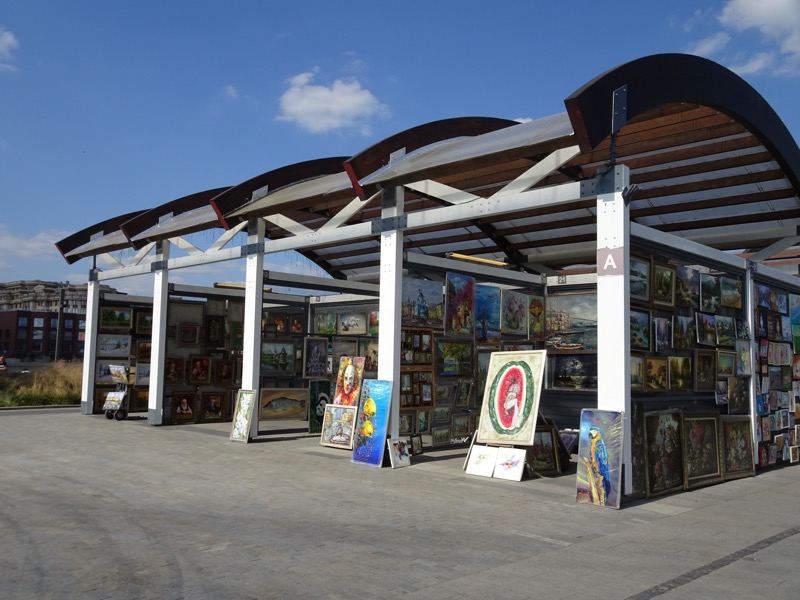



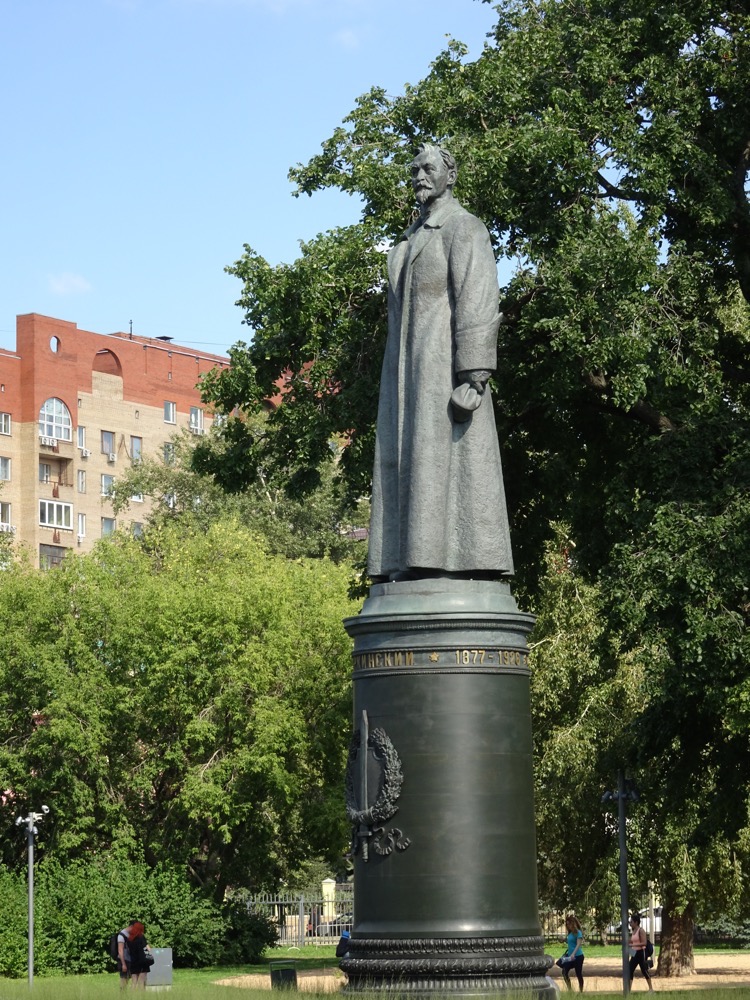












 Overall, I have to ask… ‘exercise a high degree of caution’. Yeah. Why exactly? We have thoroughly enjoyed our time here and are looking forward to seeing St Petersburg in a few weeks on the way back too.
Overall, I have to ask… ‘exercise a high degree of caution’. Yeah. Why exactly? We have thoroughly enjoyed our time here and are looking forward to seeing St Petersburg in a few weeks on the way back too.


 I am just in love with this building. It is simply spectacular.
I am just in love with this building. It is simply spectacular.





 So I got some night pictures and was very happy with my wash. Another big day. Off to the hotel with us after that – we have an early start tomorrow to transit to Stockholm… and I was now officially ‘trudging’ all the way there. My poor feet!
So I got some night pictures and was very happy with my wash. Another big day. Off to the hotel with us after that – we have an early start tomorrow to transit to Stockholm… and I was now officially ‘trudging’ all the way there. My poor feet!